This list of Mesozoic birds is a comprehensive list of all Mesozoic dinosaurs that have been assigned to the clade Avialae (birds, in the broadest sense). The list includes all commonly accepted genera, but also genera that are now considered invalid, doubtful (nomen dubium), or were not formally published (nomen nudum), as well as junior synonyms of more established names, and genera that are no longer considered avialan. The list currently includes 263 genera.
Scope and terminology
There is no official, canonical list of Mesozoic bird genera, but some of the more complete ones include Holtz's list of Mesozoic dinosaurs,[1] Molina-Perez & Larramendi's list of theropods,[2] and Mickey Mortimer's Theropod Database.[3] Lists of ex-birds are generally rare, but one example is the "Ex-Saurischian Taxa and Basal Saurischians" section of the Theropod Database.[4]
Authors and year
The authors column lists the authors of the formal description responsible for the erection of the genus listed. They are not necessarily the same as the authors of the type species, as sometimes a species from one genus is determined sufficiently distinct to warrant the erection of a new genus to house it. If this is the case, only the latter authors will be listed. The year column notes the year the genus' description was published.
Status
Naming conventions and terminology follow the International Code of Zoological Nomenclature (ICZN). Technical terms used include:
- Junior synonym: A name which describes the same taxon as a previously published name. If two or more genera are formally designated and the type specimens are later assigned to the same genus, the first to be published (in chronological order) is the senior synonym, and all other instances are junior synonyms. Senior synonyms are generally used, except by special decision of the ICZN, but junior synonyms cannot be used again, even if deprecated. Junior synonymy is often subjective, unless the genera described were both based on the same type specimen.
- Nomen nudum (Latin for "naked name"): A name that has appeared in print but has not yet been formally published by the standards of the ICZN. Nomina nuda (the plural form) are invalid, and are therefore not italicized as a proper generic name would be. If the name is later formally published, that name is no longer a nomen nudum and will be italicized on this list. Often, the formally published name will differ from any nomina nuda that describe the same specimen.
- Preoccupied name: A name that is formally published, but which has already been used for another taxon. This second use is invalid (as are all subsequent uses) and the name must be replaced.
- Nomen dubium (Latin for "dubious name"): A name describing a fossil with no unique diagnostic features. As this can be an extremely subjective and controversial designation, this term is not used on this list.
Age
The age column denotes the epoch of geologic time to which the fossils date. Genera that are invalid, misidentified, or otherwise do not represent a valid Mesozoic bird are listed as age N/A because there was never a time in which a Mesozoic bird by that generic name actually lived.
Location and notes
The location column designates the geographic region where remains of the relevant genus have been found. The regions used are countries, despite the fact that there were no political boundaries in Mesozoic times; they are only used for convenience. Genera that are invalid, misidentified, or otherwise do not represent a valid Mesozoic bird are listed as location N/A because there was never a place in which a Mesozoic bird by that generic name actually lived. The notes column is a collection of annotations on the scientific significance and taxonomic history of listed genera, as well as elaborations on the information presented in other columns.
List
| Genus | Authors | Year | Status | Age | Location | Notes | Images |
|---|---|---|---|---|---|---|---|
| Abavornis[5] | Panteleyev | 1998 | Valid | Late Cretaceous | Uzbekistan | ||
| Aberratiodontus[6] | Gong et al. | 2004 | Junior synonym | Early Cretaceous | China | Junior synonym of Yanornis. | |
| Abitusavis[7] | Wang et al. | 2020 | Valid | Early Cretaceous | China | ||
| Alamitornis[8] | Agonlin & Martinelli | 2009 | Valid | Late Cretaceous | Argentina | ||
| Alcmonavis[9] | Rauhut et al. | 2019 | Valid | Late Jurassic | Germany |  | |
| Alethoalaornis | Li et al. | 2007 | Valid | Early Cretaceous | China | ||
| Alexornis[10] | Brodkorb | 1976 | Valid | Late Cretaceous | Mexico | ||
| Ambiortus | Kurochkin | 1982 | Valid | Early Cretaceous | Mongolia | ||
| Ambopteryx[11] | Wang et al. | 2019 | Valid | Late Jurassic | China | Considered a non-avialan theropod by some researchers. | 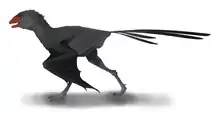 |
| Anatalavis | Olson & Parris | 1987 | Valid | Late Cretaceous | United States England |
The type species is known from the Late Cretaceous–Paleocene border, while a referred species is from the Eocene. | |
| Anchiornis[12] | Xu et al. | 2009 | Valid | Late Jurassic | China | Considered a non-avialan theropod by some researchers. | 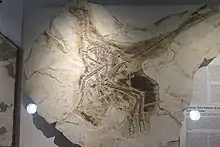 |
| Angelinornis | Kashin | 1972 | Junior synonym | Late Cretaceous | United States | Junior synonym of Ichthyornis. | |
| Antarcticavis[13] | Cordes-Person et al. | 2020 | Valid | Late Cretaceous | Antarctica | ||
| Apatornis | Marsh | 1873 | Valid | Late Cretaceous | United States |  | |
| Apsaravis[14] | Norell & Clarke | 2001 | Valid | Late Cretaceous | Mongolia | ||
| Archaeopteryx[15] | Meyer | 1861 | Valid | Late Jurassic | Germany | Considered a non-avialan theropod by some researchers. | .jpg.webp) |
| Archaeorhynchus[16] | Zhou & Zhang | 2006 | Valid | Early Cretaceous | China | 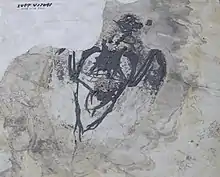 | |
| Archaeornis | Petronievics | 1917 | Junior synonym | Late Jurassic | Germany | Junior synonym of Archaeopteryx. | |
| Archaeornithura[17] | Wang et al. | 2015 | Valid | Early Cretaceous | China |  | |
| Archaeovolans | Czerkas & Xu | 2002 | Junior synonym | Early Cretaceous | China | Junior synonym of Yanornis. | |
| Asiahesperornis | Nesov & Prizemlin | 1991 | Valid | Late Cretaceous | Kazakhstan | ||
| Asteriornis[18] | Field et al. | 2020 | Valid | Late Cretaceous | Belgium | 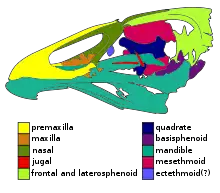 | |
| Aurornis[19] | Godefroit et al. | 2013 | Valid | Late Jurassic | China | Considered a non-avialan theropod by some researchers. | 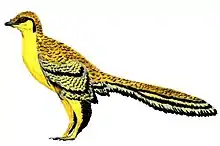 |
| Austinornis[20] | Clarke | 2004 | Valid | Late Cretaceous | United States | ||
| Avimaia[21] | Bailleul et al. | 2019 | Valid | Early Cretaceous | China | 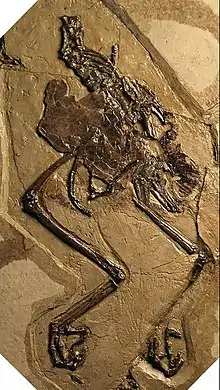 | |
| Avisaurus[22] | Brett-Surman & Paul | 1985 | Valid | Late Cretaceous | United States | 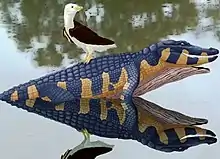 | |
| Balaur[23] | Csiki et al. | 2010 | Valid | Late Cretaceous | Romania | Originally (and sometimes still) thought to be a non-avialan theropod. | 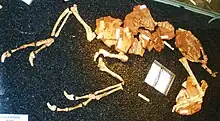 |
| Baptornis | Marsh | 1877 | Valid | Late Cretaceous | United States | 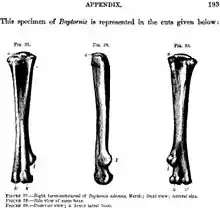 | |
| Bauxitornis[24] | Dyke & Ősi | 2010 | Valid | Late Cretaceous | Hungary | 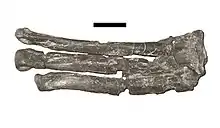 | |
| Beiguornis[25] | Wang et al. | 2022 | Valid | Early Cretaceous | China | ||
| Bellulia | Wang et al. | 2016a | Preoccupied | N/A | N/A | Name preoccupied by the moth Bellulia Fibiger 2008 and replaced by Bellulornis. | |
| Bellulornis | Wang et al. | 2016b | Valid | Early Cretaceous | China | ||
| Bohaiornis[26] | Hu et al. | 2011 | Valid | Early Cretaceous | China | 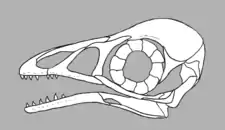 | |
| Boluochia[27] | Zhou | 1995 | Valid | Early Cretaceous | China | ||
| Bradycneme[28] | Harrison & Walker | 1975 | Misidentification | N/A | N/A | Originally described as a bird; more likely a non-avialan theropod. | |
| Brevidentavis[29] | O'Connor et al. | 2021 | Valid | Early Cretaceous | China | ||
| Brevirostruavis[30] | Li et al. | 2021 | Valid | Early Cretaceous | China | ||
| Brodavis[31] | Martin et al. | 2012 | Valid | Late Cretaceous | United States Mongolia |
||
| Caihong[32] | Hu et al. | 2018 | Valid | Late Jurassic | China | Considered to be a non-avialan theropod by some researchers. | 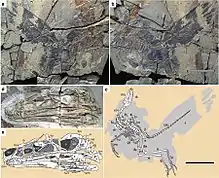 |
| Camptodontornis[33] | Demirjian | 2019 | Valid | Early Cretaceous | China | ||
| Camptodontus[34] | Li et al. | 2010 | Preoccupied | N/A | N/A | Name preoccupied by the beetle Camptodontus Dejean, 1826 and replaced by Camptodontornis. | |
| Canadaga[35] | Hou | 1999 | Valid | Late Cretaceous | Canada | ||
| Castignovolucris[36] | Buffetaut et al. | 2023 | Valid | Late Cretaceous | France | ||
| Catenoleimus[5] | Panteleyev | 1998 | Valid | Late Cretaceous | Uzbekistan | ||
| Cathayornis | Zhou et al. | 1992 | Valid | Early Cretaceous | China | 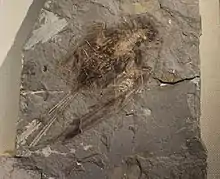 | |
| Ceramornis[37] | Brodkorb | 1963 | Valid | Late Cretaceous | United States | ||
| Cerebavis[38] | Kurochkin et al. | 2006 | Valid | Late Cretaceous | Russia | ||
| Changchengornis[39] | Ji et al. | 1999 | Valid | Early Cretaceous | China |  | |
| Changmaornis[40] | Wang et al. | 2013 | Valid | Early Cretaceous | China | 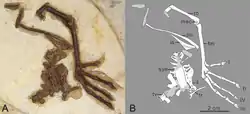 | |
| Changzuiornis[41] | Huang et al. | 2016 | Disputed | Early Cretaceous | China | Possibly synonymous with Juehuaornis. | |
| Chaoyangia | Hou & Zhang | 1993 | Valid | Early Cretaceous | China | ||
| Chiappeavis[42] | O'Connor et al. | 2016 | Valid | Early Cretaceous | China | ||
| Chongmingia[43] | Wang et al. | 2016 | Valid | Early Cretaceous | China | ||
| Chupkaornis[44] | Tanaka et al. | 2017 | Valid | Late Cretaceous | Japan | ||
| Cimoliornis | Owen | 1846 | Misidentification | N/A | N/A | Originally described as a bird; actually a pterosaur. | |
| Cimolopteryx | Marsh | 1892 | Valid | Late Cretaceous | United States | May be Paleocene. | 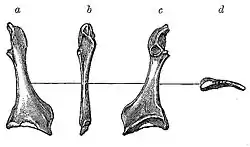 |
| Colonosaurus[45] | Marsh | 1872 | Junior synonym | Late Cretaceous | United States | Junior synonym of Ichthyornis. | |
| Concornis[46] | Sanz & Buscalioni | 1992 | Valid | Early Cretaceous | Spain | 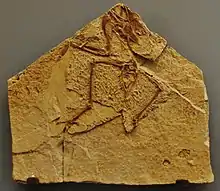 | |
| Confuciusornis[47] | Hou et al. | 1995 | Valid | Early Cretaceous | China | 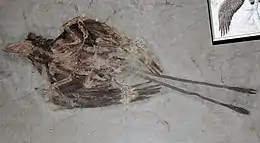 | |
| Coniornis | Marsh | 1893 | Junior synonym | Late Cretaceous | United States | Junior synonym of Hesperornis. | |
| Cosesaurus[48] | Ellenberger & de Villalta | 1974 | Misidentification | N/A | N/A | Sometimes proposed to be a bird ancestor; actually a tanystropheid. | |
| Cratoavis[49] | Carvalho et al. | 2015 | Valid | Early Cretaceous | Brazil | ||
| Cratonavis[50] | Li et al. | 2023 | Valid | Early Cretaceous | China | ||
| Cretaaviculus | Bazhanov | 1969 | Valid | Late Cretaceous | Kazakhstan | ||
| Cretornis[51] | Fritsch | 1880 | Misidentification | N/A | N/A | Originally described as a bird; actually a pterosaur. | |
| Cruralispennia[52] | Wang et al. | 2017 | Valid | Early Cretaceous | China | 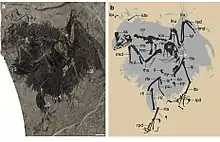 | |
| Cuspirostrisornis[53] | Hou | 1997 | Valid | Early Cretaceous | China | ||
| Dalianraptor | Gao & Liu | 2005 | Disputed | N/A | N/A | Likely a chimaera consisting of a Jeholornis and another theropod. | |
| Dalingheornis[54] | Zhang et al. | 2006 | Valid | Early Cretaceous | China | ||
| Dapingfangornis[55] | Li et al. | 2006 | Valid | Early Cretaceous | China | ||
| Didactylornis[56] | Yuan | 2008 | Junior synonym | Early Cretaceous | China | Junior synonym of Sapeornis. | |
| Dingavis[57] | O'Connor et al. | 2016 | Disputed | Early Cretaceous | China | Possibly synonymous with Changzuiornis and/or Juehuaornis. | |
| Dunhuangia[58] | Wang et al. | 2015 | Valid | Early Cretaceous | China | ||
| Elbretornis[59] | Walker & Dyke | 2009 | Valid | Late Cretaceous | Argentina | Possibly synonymous with Lectavis, Soroavisaurus and/or Yungavolucris. | |
| Elektorornis[60] | Xing et al. | 2019 | Valid | Early Cretaceous | Myanmar | ||
| Elopteryx[61] | Andrews | 1913 | Misidentification | N/A | N/A | Originally described as a bird; more likely to be a non-avialan theropod. | 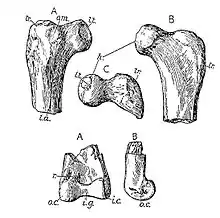 |
| Elsornis[62] | Chiappe et al. | 2007 | Valid | Late Cretaceous | Mongolia | ||
| Enaliornis | Seeley | 1876 | Valid | Late Cretaceous | England | ||
| Enantiophoenix[63] | Cau & Arduini | 2008 | Valid | Late Cretaceous | Lebanon | ||
| Enantiornis[64] | Walker | 1981 | Valid | Late Cretaceous | Argentina |  | |
| Eoalulavis[65] | Sanz et al. | 1996 | Valid | Early Cretaceous | Spain | ||
| Eocathayornis[66] | Zhou | 2002 | Valid | Early Cretaceous | China | ||
| Eoconfuciusornis[67] | Zhang et al. | 2008 | Valid | Early Cretaceous | China | 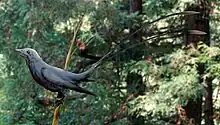 | |
| Eoenantiornis[68] | Hou et al. | 1999 | Valid | Early Cretaceous | China | 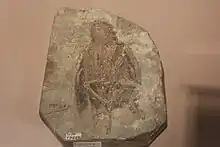 | |
| Eogranivora[69] | Zheng et al. | 2018 | Valid | Early Cretaceous | China | 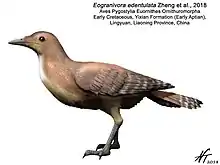 | |
| Eopengornis | Wang et al. | 2014 | Valid | Early Cretaceous | China | ||
| Eosinopteryx[70] | Godefroit et al. | 2013 | Valid | Late Jurassic | China | Considered a non-avialan theropod by some researchers. | 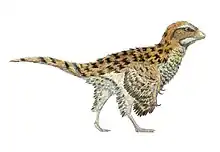 |
| Epidendrosaurus[71] | Zhang et al. | 2002 | Junior synonym | Late Jurassic | China | Possible synonym of Scansoriopteryx. | |
| Epidexipteryx[72] | Zhang et al. | 2008 | Valid | Late Jurassic | China | Considered a non-avialan theropod by some researchers. | 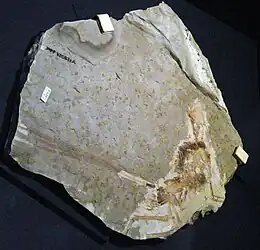 |
| Eurolimnornis[73] | Kessler & Jurcsák | 1986 | Misidentification | N/A | N/A | Originally described as a bird; reinterpreted as a pterodactyloid pterosaur. | |
| Evgenavis[74] | O'Connor et al. | 2014 | Valid | Early Cretaceous | Russia | ||
| Explorornis[5] | Panteleyev | 1998 | Valid | Late Cretaceous | Uzbekistan | ||
| Falcatakely[75] | O'Connor et al. | 2020 | Valid | Late Cretaceous | Madagascar | ||
| Feitianius[76] | O'Connor et al. | 2015 | Valid | Early Cretaceous | China | ||
| Flexomornis[77] | Tykoski & Fiorillo | 2010 | Valid | Late Cretaceous | United States | ||
| Fortipesavis[78] | Clark & O'Connor | 2021 | Valid | Early Cretaceous | Myanmar | ||
| Fortunguavis[79] | Wang et al. | 2014 | Valid | Early Cretaceous | China | ||
| Fujianvenator[80] | Xu et al. | 2023 | Valid | Late Jurassic | China | Found within the family Anchiornithidae, which may represent non-avialan dinosaurs | |
| Fukuipteryx[81] | Imai et al. | 2019 | Valid | Early Cretaceous | Japan | %252C_dorsal_(b)%252C_and_left-lateral_(c)_views._d_Life_restoration_of_Fukuipteryx_prima.webp.png.webp) | |
| Fumicollis[82] | Bell & Chiappe | 2015 | Valid | Late Cretaceous | United States | ||
| Gallornis | Lambrecht | 1931 | Valid | Early Cretaceous | France | ||
| Gansus[83] | Hou & Liu | 1984 | Valid | Early Cretaceous | China | 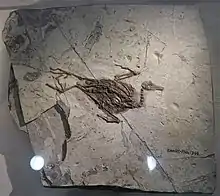 | |
| Gargantuavis[84] | Buffetaut & Le Loeuff | 1998 | Valid | Late Cretaceous | France Spain Romania |
 | |
| Gettyia[85] | Atterholt et al. | 2018 | Valid | Late Cretaceous | United States | ||
| Gobipipus[86] | Kurochkin & Chatterjee | 2013 | Valid | Early Cretaceous | Mongolia | Very similar to embryonic Gobipteryx. | |
| Gobipteryx[87] | Elżanowski | 1994 | Valid | Late Cretaceous | Mongolia | ||
| Grabauornis[88] | Dalsätt et al. | 2014 | Valid | Early Cretaceous | China | ||
| Gracilornis[89] | Li & Hou | 2011 | Valid | Early Cretaceous | China | ||
| Graculavus | Marsh | 1872 | Valid | Late Cretaceous | United States | May be Paleocene. | |
| Gretcheniao | Chiappe et al. | 2019 | Valid | Early Cretaceous | China | ||
| Griphornis | Woodward | 1862 | Junior synonym | Late Jurassic | Germany | Name officially rejected in favor of Archaeopteryx. | |
| Griphosaurus | Wagner | 1862 | Junior synonym | Late Jurassic | Germany | Name officially rejected in favor of Archaeopteryx. | |
| Guildavis[20] | Clarke | 2004 | Valid | Late Cretaceous | United States | ||
| Gurilynia[90] | Kurochkin | 1999 | Valid | Late Cretaceous | Mongolia | ||
| Halimornis[91] | Chiappe | 2002 | Valid | Late Cretaceous | United States | ||
| Hargeria | Lucas | 1903 | Junior synonym | Late Cretaceous | United States | Junior synonym of Hesperornis. | |
| "Hebeiornis"[92] | Xu et al. | 1999 | Nomen nudum | N/A | N/A | Synonym of Vescornis due to being based on the same holotype. However, despite predating the description of Vescornis by five years, its description is so poor that it is regarded as a nomen nudum and a synonym. | |
| Heptasteornis[28] | Harrison & Walker | 1975 | Misidentification | N/A | N/A | Originally described as a bird; more likely a non-avialan theropod. | |
| Hesperornis | Marsh | 1872 | Valid | Late Cretaceous | United States Canada Russia |
.jpg.webp) | |
| Holbotia[93] | Zelenkov & Averianov | 2015 | Valid | Early Cretaceous | Mongolia | ||
| Hollanda[94] | Bell et al. | 2010 | Valid | Late Cretaceous | Mongolia | 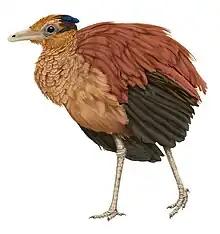 | |
| Hongshanornis[95] | Zhou & Zhang | 2005 | Valid | Early Cretaceous | China | _of_Hongshanornis_longicresta.jpg.webp) | |
| Horezmavis | Nessov & Borkin | 1983 | Valid | Late Cretaceous | Uzbekistan | ||
| Houornis[96] | Wang & Liu | 2015 | Valid | Early Cretaceous | China | ||
| Huoshanornis[97] | Wang et al. | 2010 | Valid | Early Cretaceous | China | ||
| Iaceornis[20] | Clarke | 2004 | Valid | Late Cretaceous | United States | ||
| Iberomesornis[98] | Sanz & Bonaparte | 1992 | Valid | Early Cretaceous | Spain |  | |
| Ichthyornis | Marsh | 1873 | Valid | Late Cretaceous | United States | 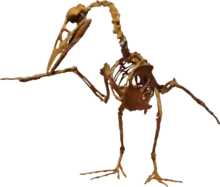 | |
| Ilerdopteryx | Lacasa-Ruiz | 1985 | Valid | Early Cretaceous | Spain | ||
| Incolornis[5] | Panteleyev | 1998 | Valid | Late Cretaceous | Uzbekistan | ||
| Intiornis[99] | Novas et al. | 2010 | Valid | Late Cretaceous | Argentina |  | |
| Iteravis | Zhou et al. | 2014 | Valid | Early Cretaceous | China | ||
| Janavis[100] | Benito et al. | 2022 | Valid | Late Cretaceous | Belgium | ||
| Jeholornis[101] | Zhou et al. | 2002 | Valid | Early Cretaceous | China | 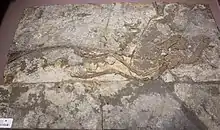 | |
| Jianchangornis[102] | Zhou et al. | 2009 | Valid | Early Cretaceous | China | ||
| Jibeinia[53] | Hou | 1997 | Valid | Early Cretaceous | China | ||
| Jinfengopteryx[103] | Ji et al. | 2005 | Misidentification | N/A | N/A | Originally described as a bird; actually a non-avian dinosaur. | |
| Jinguofortis[104] | Wang et al. | 2018 | Valid | Early Cretaceous | China | 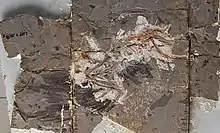 | |
| Jinzhouornis | Hou et al. | 2002 | Junior synonym | Early Cretaceous | China | Junior synonym of Confuciusornis. | |
| Jiuquanornis[40] | Wang et al. | 2013 | Valid | Early Cretaceous | China | 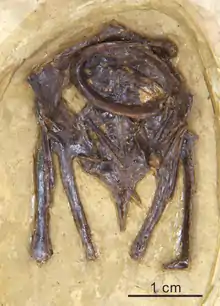 | |
| Jixiangornis[105] | Ji et al. | 2002 | Valid | Early Cretaceous | China | 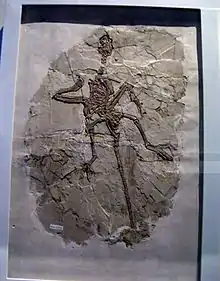 | |
| Judinornis | Nessov & Borkin | 1983 | Valid | Late Cretaceous | Mongolia | ||
| Juehuaornis[106] | Wang et al. | 2015 | Valid | Early Cretaceous | China | ||
| Junornis[107] | Liu et al. | 2017 | Valid | Early Cretaceous | China | 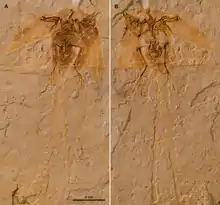 | |
| Jurapteryx | Howgate | 1984 | Junior synonym | Late Jurassic | Germany | Junior synonym of Archaeopteryx. | |
| Kaririavis[108] | Carvalho et al. | 2021 | Valid | Early Cretaceous | Brazil | ||
| Khinganornis[109] | Wang et al. | 2020 | Valid | Early Cretaceous | China | ||
| Kizylkumavis[110] | Nessov | 1984 | Valid | Late Cretaceous | Uzbekistan | ||
| Kompsornis[111] | Wang et al. | 2020 | Valid | Early Cretaceous | China | ||
| Kookne | Novas et al. | 2019 | Valid | Late Cretaceous | Argentina | ||
| Kuszholia[112] | Nesov | 1992 | Valid | Late Cretaceous | Uzbekistan | ||
| Lamarqueavis[113] | Agnolin | 2010 | Valid | Late Cretaceous | Argentina United States Canada |
||
| Laopteryx[114] | Marsh | 1881 | Misidentification | N/A | N/A | Originally described as a bird; actually a pterosaur. | |
| Laornis[115] | Marsh | 1870 | Valid | Late Cretaceous | United States | May be Paleocene. | |
| Largirostrornis[53] | Hou | 1997 | Disputed | Early Cretaceous | China | Possible synonym of Cathayornis. | |
| Lectavis[116] | Chiappe | 1993 | Valid | Late Cretaceous | Argentina | ||
| Lenesornis[117] | Kurochkin | 1996 | Valid | Late Cretaceous | Uzbekistan | ||
| Lestornis[118] | Marsh | 1876 | Junior synonym | Late Cretaceous | United States | Junior synonym of Hesperornis. | |
| Liaoningornis[119] | Hou | 1996 | Valid | Early Cretaceous | China | ||
| Liaoxiornis[120] | Hou & Chen | 1999 | Valid | Early Cretaceous | China | 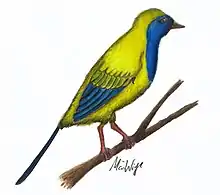 | |
| Limenavis[121] | Clarke & Chiappe | 2001 | Valid | Late Cretaceous | Argentina | ||
| Limnornis[122] | Kessler & Jurcsak | 1984 | Misidentification | N/A | N/A | Name preoccupied by the ovenbird Limnornis Gould 1839 and replaced by Palaeocursornis. Originally described as a bird; actually a pterosaur. | |
| Lingyuanornis[123] | Ji & Ji | 1999 | Junior synonym | N/A | N/A | Junior synonym of Liaoxiornis as it is based on the same holotype. | |
| Linyiornis[124] | Wang et al. | 2016 | Valid | Early Cretaceous | China | ||
| Lisboasaurus[125] | Seiffert | 1970 | Misidentification | N/A | N/A | Sometimes proposed to be a bird; actually a crocodilian. | |
| Lonchodytes[37] | Brodkorb | 1963 | Valid | Late Cretaceous | United States | May be Paleocene. | |
| Longchengornis[53] | Hou | 1997 | Disputed | Early Cretaceous | China | Possible synonym of Cathayornis. | |
| Longicrusavis[126] | O'Connor et al. | 2010 | Valid | Early Cretaceous | China | ||
| Longipteryx[127] | Zhang et al. | 2001 | Valid | Early Cretaceous | China | 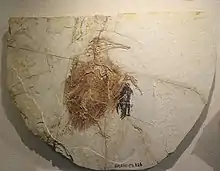 | |
| Longirostravis[128] | Hou et al. | 2004 | Valid | Early Cretaceous | China | 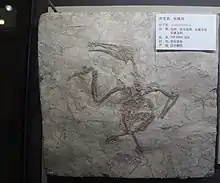 | |
| Longisquama[129] | Sharov | 1970 | Misidentification | N/A | N/A | Sometimes proposed to be a bird ancestor; actually an indeterminate reptile. | |
| Longusunguis[130] | Wang et al. | 2014 | Valid | Early Cretaceous | China | 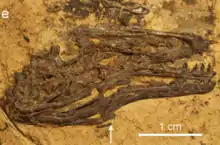 | |
| Maaqwi[131] | McLachlan et al. | 2017 | Valid | Late Cretaceous | Canada | ||
| Martinavis[132] | Walker et al. | 2007 | Valid | Late Cretaceous | France Argentina |
||
| Meemannavis[29] | O'Connor et al. | 2021 | Valid | Early Cretaceous | China | ||
| Megalancosaurus[133] | Calzavara et al. | 1980 | Misidentification | N/A | N/A | Sometimes proposed to be a bird ancestor, but actually a drepanosaurid. | |
| Mengciusornis[134] | Wang et al. | 2019 | Valid | Early Cretaceous | China | ||
| Microenantiornis | Wei & Li | 2017 | Valid | Early Cretaceous | China | ||
| Mirarce[85] | Atterholt et al. | 2018 | Valid | Late Cretaceous | United States | 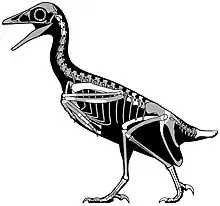 | |
| Mirusavis[135] | Wang et al. | 2020 | Valid | Early Cretaceous | China | ||
| Monoenantiornis[136] | Hu & O'Connor | 2016 | Valid | Early Cretaceous | China | ||
| Musivavis[137] | Wang et al. | 2022 | Valid | Early Cretaceous | China | ||
| Mystiornis[138] | Kurochkin et al. | 2011 | Valid | Early Cretaceous | Russia | ||
| Nanantius[139] | Molnar | 1986 | Valid | Early Cretaceous | Australia | ||
| Neimengornis[140] | Wang et al. | 2021 | Valid | Early Cretaceous | China | ||
| Neogaeornis[141] | Lambrecht | 1929 | Valid | Late Cretaceous | Chile | ||
| Neuquenornis[142] | Chiappe & Calvo | 1994 | Valid | Late Cretaceous | Argentina | ||
| Noguerornis[143] | Lacasa-Ruiz | 1989 | Valid | Early Cretaceous | Spain | ||
| Novacaesareala | Parris & Hope | 2002 | Valid | Late Cretaceous | United States | May be Paleocene. | |
| Oculudentavis[144] | Xing et al. | 2020 | Misidentification | N/A | N/A | Originally described as a bird; reinterpreted as an indeterminate lizard. | |
| Omnivoropteryx[145] | Czerkas & Ji | 2002 | Valid | Early Cretaceous | China | ||
| Orienantius | Liu et al. | 2019 | Valid | Early Cretaceous | China | ||
| Ostromia[146] | Foth & Rauhut | 2017 | Valid | Late Jurassic | Germany | Considered a non-avialan theropod by some researchers. | 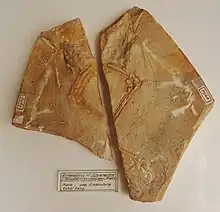 |
| Otogornis | Hou | 1994 | Valid | Early Cretaceous | China | ||
| Palaeocursornis[73] | Kessler & Jurcsak | 1986 | Misidentification | N/A | N/A | Originally described as a bird; actually a pterosaur. | |
| Palaeonornis | Emmons | 1857 | Misidentification | N/A | N/A | Originally described as a bird; actually a junior synonym of the phytosaur Rutiodon.[4] | |
| Palaeopteryx | Jensen | 1981 | Misidentification | N/A | N/A | Originally described as a bird; more likely a non-avian theropod. | |
| Palaeornis | Mantell | 1844 | Misidentification | N/A | N/A | Name preoccupied by the parrot Palaeornis Vigors 1825. Originally described as a bird; actually a pterosaur. | |
| Palaeotringa | Marsh | 1870 | Valid | Late Cretaceous | United States | May be Paleocene. | |
| Palintropus[147] | Brodkorb | 1970 | Valid | Late Cretaceous | United States Canada |
||
| Parabohaiornis[130] | Wang et al. | 2014 | Valid | Early Cretaceous | China | ||
| Parahesperornis[148] | Martin | 1984 | Valid | Late Cretaceous | United States | 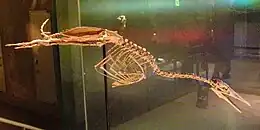 | |
| Parahongshanornis[149] | Li et al. | 2011 | Valid | Early Cretaceous | China | ||
| Parapengornis[150] | Hu et al. | 2015 | Valid | Early Cretaceous | China | 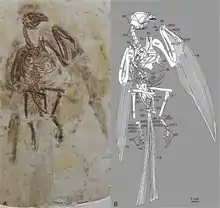 | |
| Paraprotopteryx[151] | Zheng et al. | 2007 | Valid | Early Cretaceous | China | ||
| Parascaniornis | Lambrecht | 1933 | Junior synonym | Late Cretaceous | Sweden | Junior synonym of Baptornis. | |
| Parvavis[152] | Wang et al. | 2014 | Valid | Late Cretaceous | China | 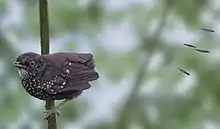 | |
| Pasquiaornis[153] | Tokaryk et al. | 1997 | Valid | Late Cretaceous | Canada | ||
| Patagopteryx[154] | Alvarenga & Bonaparte | 1992 | Valid | Late Cretaceous | Argentina |  | |
| Pedopenna[155] | Xu & Zhang | 2005 | Valid | Late Jurassic | China | Considered a non-avialan theropod by some researchers. | |
| Pelagornis | Seeley | 1866 | Preoccupied | N/A | N/A | Named preoccupied by the Miocene bird Pelagornis Lartet 1857 and replaced by Enaliornis. | |
| Pengornis[156] | Zhou et al. | 2008 | Valid | Early Cretaceous | China | ||
| Piksi[157] | Varricchio | 2002 | Misidentification | N/A | N/A | Originally described as a bird; reinterpreted as a pterodactyloid pterosaur. | |
| Piscivoravis[158] | Zhou et al. | 2013 | Valid | Early Cretaceous | China | 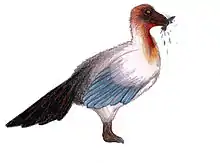 | |
| Piscivorenantiornis[159] | Wang & Zhou | 2017 | Valid | Early Cretaceous | China | ||
| Platanavis[112] | Nesov | 1992 | Valid | Late Cretaceous | Uzbekistan | ||
| Plegadornis | Wetmore | 1962 | Preoccupied | N/A | N/A | Name preoccupied by the modern bird Plegadornis Brehm 1855; junior synonym of Ichthyornis. | |
| Polarornis[160] | Chatterjee | 2002 | Valid | Late Cretaceous | Antarctica | ||
| Potamornis[161] | Elzanowski et al. | 2001 | Valid | Late Cretaceous | United States | ||
| Praeornis[162] | Rautian | 1978 | Valid | Late Jurassic | Kazakhstan | ||
| Priscavolucris[163] | Gomez Pallerola | 1979 | Misidentification | N/A | N/A | Originally described as a bird; reinterpreted as a hybodontiform fish.[164] | |
| "Proornis" | Lim | 1993 | Nomen nudum | N/A | N/A | 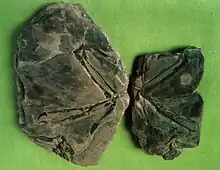 | |
| Protarchaeopteryx[165] | Ji & Ji | 1997 | Misidentification | N/A | N/A | Originally described as a bird; actually a non-avian dinosaur. | |
| Protoavis[166] | Chatterjee | 1991 | Misidentification | N/A | N/A | Originally described as a bird; more likely a chimaera of several vertebrates. | |
| Protopteryx[167] | Zhang & Zhou | 2000 | Valid | Early Cretaceous | China | _NMNS.jpg.webp) | |
| Pterodactylus[168] | Rafinesque | 1815 | Misidentification | N/A | N/A | Sometimes thought to be a bird before being described as a pterosaur. | |
| Pterygornis[169] | Wang et al. | 2015 | Valid | Early Cretaceous | China | ||
| Qiliania[170] | Ji et al. | 2011 | Valid | Early Cretaceous | China | ||
| Rahona[171] | Forster et al. | 1998a | Preoccupied | N/A | N/A | Name preoccupied by the moth Rahona Griveaud 1975 and replaced by Rahonavis. | |
| Rahonavis[172] | Forster et al. | 1998b | Valid | Late Cretaceous | Madagascar | Considered a non-avialan theropod by some researchers. |  |
| Rapaxavis[173] | Morschhauser et al. | 2009 | Valid | Early Cretaceous | China | 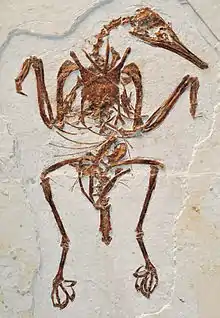 | |
| Rhamphorhynchus[174] | Meyer | 1846 | Misidentification | N/A | N/A | Originally thought to be a bird before being described as a pterosaur. | |
| Samrukia[175] | Naish et al. | 2012 | Misidentification | N/A | N/A | Originally described as a bird; actually a pterosaur. | |
| Sapeornis[176] | Zhou & Zhang | 2002 | Valid | Early Cretaceous | China |  | |
| Sazavis[177] | Nesov | 1989 | Valid | Late Cretaceous | Uzbekistan | ||
| Scansoriopteryx[178] | Czerkas & Yuan | 2002 | Valid | Late Jurassic | China | Considered a non-avialan theropod by some researchers. |  |
| Schizooura[179] | Zhou et al. | 2012 | Valid | Early Cretaceous | China | ||
| Serikornis[180] | Lefèvre et al. | 2017 | Valid | Late Jurassic | China | Considered a non-avialan theropod by some researchers. | 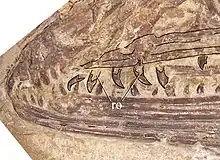 |
| Shangyang | Wang & Zhou | 2019 | Valid | Early Cretaceous | China | ||
| Shanweiniao[181] | O'Connor et al. | 2009 | Valid | Early Cretaceous | China | 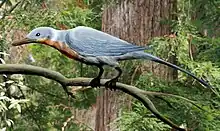 | |
| Shengjingornis[182] | Li et al. | 2012 | Valid | Early Cretaceous | China | ||
| Shenqiornis[183] | Wang et al. | 2010 | Valid | Early Cretaceous | China | ||
| Shenshiornis[184] | Hu | 2010 | Junior synonym | Early Cretaceous | China | Junior synonym of Sapeornis. | |
| Shenzhouraptor[185] | Ji et al. | 2002 | Disputed | Early Cretaceous | China | Possible synonym of Jeholornis. | |
| Similiyanornis[7] | Wang et al. | 2020 | Valid | Early Cretaceous | China | ||
| Sinornis[186] | Sereno & Rao | 1992 | Valid | Early Cretaceous | China | 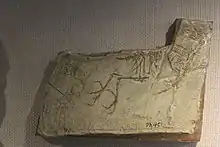 | |
| Songlingornis[53] | Hou | 1997 | Valid | Early Cretaceous | China | ||
| Soroavisaurus[187] | Chiappe | 1993 | Valid | Late Cretaceous | Argentina | ||
| Struthiosaurus[188] | Bunzel | 1871 | Misidentification | N/A | N/A | Originally thought to be a bird; actually an ankylosaurian dinosaur. | |
| "Styginetta" | Stidham | 2001 | Nomen nudum | N/A | N/A | Obscure; named in a thesis. | |
| Sulcavis[189] | O'Connor et al. | 2013 | Valid | Early Cretaceous | China |  | |
| Telmatornis | Marsh | 1870 | Valid | Late Cretaceous | United States | ||
| Teviornis[190] | Kurochkin et al. | 2002 | Valid | Late Cretaceous | Mongolia | ||
| Tianyuornis[191] | Zheng et al. | 2014 | Valid | Early Cretaceous | China | ||
| Tingmiatornis[192] | Bono et al. | 2016 | Valid | Late Cretaceous | Canada | 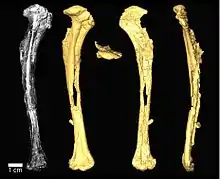 | |
| Torotix[37] | Brodkorb | 1963 | Valid | Late Cretaceous | United States | ||
| Tytthostonyx[193] | Olson & Parris | 1987 | Valid | Late Cretaceous | United States | ||
| Vegavis[194] | Clarke et al. | 2005 | Valid | Late Cretaceous | Antarctica |  | |
| Vescornis[195] | Zhang et al. | 2004 | Disputed | Early Cretaceous | China | Possible junior synonym of Jibeinia. | |
| Volgavis[177] | Nessov & Yarkov | 1989 | Valid | Late Cretaceous | Russia | ||
| Vorona[196] | Forster et al. | 1996 | Valid | Late Cretaceous | Madagascar | ||
| Wasaibpanchi | Malkani | 2021 | Disputed | Late Cretaceous | Pakistan | Publication status uncertain. | |
| Wellnhoferia[197] | Elżanowski | 2001 | Disputed | Late Jurassic | Germany | Possible junior synonym of Archaeopteryx. | 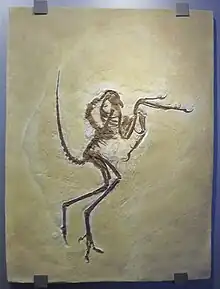 |
| Wyleyia[198] | Harrison & Walker | 1973 | Valid | Early Cretaceous | England | ||
| Xiangornis[199] | Hu et al. | 2012 | Valid | Early Cretaceous | China | ||
| Xinghaiornis[200] | Wang et al. | 2013 | Valid | Early Cretaceous | China | ||
| Xiaotingia[201] | Xu et al. | 2011 | Valid | Late Jurassic | China | Considered a non-avialan theropod by some researchers. |  |
| Yandangornis[202] | Cai & Zhao | 1999 | Valid | Late Cretaceous | China |  | |
| Yangavis[203] | Wang et al. | 2018 | Valid | Early Cretaceous | China | ||
| Yanornis[204] | Zhou & Zhang | 2001 | Valid | Early Cretaceous | China |  | |
| Yatenavis[205] | Herrera et al. | 2022 | Valid | Late Cretaceous | Argentina | ||
| Yi[206] | Xu et al. | 2015 | Valid | Late Jurassic | China | Considered a non-avialan theropod by some researchers. | 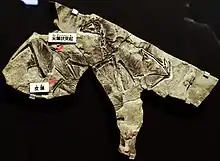 |
| Yixianornis | Zhou & Zhang | 2001 | Valid | Early Cretaceous | China | 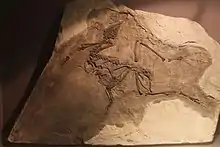 | |
| Yixianosaurus[207] | Xu & Wang | 2003 | Valid | Early Cretaceous | China | Considered a non-avialan theropod by some researchers. | .png.webp) |
| Yuanchuavis[208] | Wang et al. | 2021 | Valid | Early Cretaceous | China | 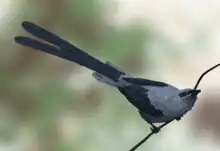 | |
| Yuanjiawaornis[209] | Hu et al. | 2015 | Valid | Early Cretaceous | China | ||
| Yumenornis[40] | Wang et al. | 2013 | Valid | Early Cretaceous | China |  | |
| Yungavolucris[210] | Chiappe | 1993 | Valid | Late Cretaceous | Argentina |  | |
| Yuornis[211] | Xu et al. | 2021 | Valid | Late Cretaceous | China | ||
| Zhongjianornis[212] | Zhou et al. | 2010 | Valid | Early Cretaceous | China | ||
| Zhongornis[213] | Gao et al. | 2008 | Valid | Early Cretaceous | China | ||
| Zhouornis[214] | Zhang et al. | 2013 | Valid | Early Cretaceous | China |  | |
| Zhylgaia[215] | Nessov | 1988 | Valid | Late Cretaceous | Kazakhstan | Dating is uncertain; may be Late Cretaceous or Paleogene. | |
| Zhyraornis[110] | Nessov | 1984 | Valid | Late Cretaceous | Uzbekistan |
See also
- List of dinosaur genera - for non-avialan dinosaurs
References
- ↑ Holtz, Thomas R. (2012). "Holtz's Genus List" (PDF).
- ↑ Molina-Pérez & Larramendi (2016). Récords y curiosidades de los dinosaurios Terópodos y otros dinosauromorfos. Spain: Larousse. pp. 277–285.
- ↑ Mortimer, Michael (2021). "Phylogeny of Taxa". Retrieved July 22, 2021.
- 1 2 Mortimer, Michael (2021). "Nontheropods cladogram test". Retrieved July 29, 2021.
- 1 2 3 4 Panteleyev, Andrey V. (1998). "New species of enantiornithines (Aves: Enantiornithes) from the Upper Cretaceous of Central Kyzylkum". Russkii Ornitologicheskii Zhurnal (in Russian). 35 (Express): 3–15.
- ↑ Gong, Enpu; Hou, Lianhai; Wang, Lixia (2004). "Enantiornithine Bird with Diapsidian Skull and Its Dental Development in the Early Cretaceous in Liaoning, China". Acta Geologica Sinica. 78 (1): 1–7.
- 1 2 Min Wang; Zhiheng Li; Qingguo Liu; Zhonghe Zhou (2020). "Two new Early Cretaceous ornithuromorph birds provide insights into the taxonomy and divergence of Yanornithidae (Aves: Ornithothoraces)". Journal of Systematic Palaeontology. 18 (21): 1805–1827. doi:10.1080/14772019.2020.1836050. S2CID 229320421.
- ↑ Federico L. Agnolin and Agustín G. Martinelli (2009). "Fossil birds from the Late Cretaceous Los Alamitos Formation, Río Negro Province, Argentina". Journal of South American Earth Sciences. Elsevier. 27 (1): 42–49. Bibcode:2009JSAES..27...42A. doi:10.1016/j.jsames.2008.09.003. ISSN 0895-9811. OCLC 263598913.
- ↑ Rauhut, Oliver WM; Tischlinger, Helmut; Foth, Christian (14 May 2019). "A non-archaeopterygid avialan theropod from the Late Jurassic of southern Germany". eLife. 8: e43789. doi:10.7554/eLife.43789. PMC 6516837. PMID 31084702.
- ↑ Brodkorb, Pierce (1976). "Discovery of a Cretaceous bird, apparently ancestral to the orders Coraciiformes and Piciformes (Aves: Carinatae)" (PDF). Smithsonian Contributions to Paleobiology. 27: 67–73.
- ↑ Wang, M.; O'Connor, J.K.; Xu, X.; Zhou, Z. (2019). "A new Jurassic scansoriopterygid and the loss of membranous wings in theropod dinosaurs". Nature. 569 (7755): 256–259. Bibcode:2019Natur.569..256W. doi:10.1038/s41586-019-1137-z. PMID 31068719. S2CID 148571099.
- ↑ Xu, X; Zhao, Q.; Norell, M.; Sullivan, C.; Hone, D.; Erickson, G.; Wang, X.; Han, F.; Guo, Y. (2009). "A new feathered maniraptoran dinosaur fossil that fills a morphological gap in avian origin". Chinese Science Bulletin. 54 (3): 430–435. Bibcode:2009SciBu..54..430X. doi:10.1007/s11434-009-0009-6.
- ↑ Amanda Cordes-Person; Carolina Acosta Hospitaleche; Judd Case; James Martin (2020). "An enigmatic bird from the lower Maastrichtian of Vega Island, Antarctica". Cretaceous Research. 108: Article 104314. Bibcode:2020CrRes.10804314C. doi:10.1016/j.cretres.2019.104314. S2CID 213442204.
- ↑ Norell, Mark A.; Clarke, Julia A. (2001). "Fossil that fills a critical gap in avian evolution". Nature. 409 (6817): 181–184. Bibcode:2001Natur.409..181N. doi:10.1038/35051563. PMID 11196639. S2CID 4377596.
- ↑ Meyer, Hermann von (15 August 1861). "Vogel-Federn und Palpipes priscus von Solenhofen" [Bird feathers and Palpipes priscus [a crustacean] from Solenhofen]. Neues Jahrbuch für Mineralogie, Geognosie, Geologie und Petrefaktenkunde (in German): 561.
- ↑ Zhou, Z; Zhang.F.C. (2006). "A beaked basal ornithurine bird (Aves, Ornithurae) from the Lower Cretaceous of China". Zoologica Scripta. 35 (4): 363–373. doi:10.1111/j.1463-6409.2006.00234.x. S2CID 85222311.
- ↑ Wang, M.; Zheng, X.; O'Connor, J. K.; Lloyd, G. T.; Wang, X.; Wang, Y.; Zhang, X.; Zhou, Z. (2015). "The oldest record of ornithuromorpha from the early cretaceous of China". Nature Communications. 6: 6987. Bibcode:2015NatCo...6.6987W. doi:10.1038/ncomms7987. PMC 5426517. PMID 25942493.
- ↑ Field, Daniel J.; Benito, Juan; Chen, Albert; Jagt, John W. M.; Ksepka, Daniel T. (18 March 2020). "Late Cretaceous neornithine from Europe illuminates the origins of crown birds". Nature. 579 (7799): 397–401. Bibcode:2020Natur.579..397F. doi:10.1038/s41586-020-2096-0. ISSN 1476-4687. PMID 32188952. S2CID 212937591.
- ↑ Godefroit, Pascal; Cau, Andrea; Hu, Dong-Yu; Escuillié, François; Wu, Wenhao; Dyke, Gareth (2013). "A Jurassic avialan dinosaur from China resolves the early phylogenetic history of birds". Nature. 498 (7454): 359–362. Bibcode:2013Natur.498..359G. doi:10.1038/nature12168. PMID 23719374. S2CID 4364892.
- 1 2 3 Clarke, J.A (2004). "Morphology, phylogenetic taxonomy, and systematics of Ichthyornis and Apatornis (Avialae: Ornithurae)" (PDF). Bulletin of the American Museum of Natural History. 286: 1–179. doi:10.1206/0003-0090(2004)286<0001:MPTASO>2.0.CO;2. S2CID 84035285.
- ↑ Bailleul, Alida M.; et al. (20 March 2019). "An Early Cretaceous enantiornithine (Aves) preserving an unlaid egg and probable medullary bone". Nature Communications. 10 (1275): 1275. Bibcode:2019NatCo..10.1275B. doi:10.1038/s41467-019-09259-x. PMC 6426974. PMID 30894527.
- ↑ Brett-Surman, Michael K.; Paul, Gregory S (1985). "A new family of bird-like dinosaurs linking Laurasia and Gondwanaland". Journal of Vertebrate Paleontology. 5 (2): 133–138. doi:10.1080/02724634.1985.10011851.
- ↑ Z., Csiki; Vremir, M.; Brusatte, S. L.; Norell, M. A. (2010). "An aberrant island-dwelling theropod dinosaur from the Late Cretaceous of Romania". Proceedings of the National Academy of Sciences of the United States of America. 107 (35): 15357–15361. Bibcode:2010PNAS..10715357C. doi:10.1073/pnas.1006970107. PMC 2932599. PMID 20805514.
- ↑ Gareth J. Dyke; Attila Ősi (2010). "A review of Late Cretaceous fossil birds from Hungary". Geological Journal. 45 (4): 434–444. doi:10.1002/gj.1209. S2CID 128580503.
- ↑ Wang X, Ju S, Wu W, Liu Y, Guo Z, Ji Q (2022). "The first enantiornithine bird from the Lower Cretaceous Longjiang Formation in the Great Khingan Range of Inner Mongolia". Acta Geologica Sinica.
- ↑ Hu, Dongyu; Li, Li; Hou, Lianhaim; Xu, Xing (2011). "A new enantiornithine bird from the Lower Cretaceous of western Liaoning, China". Journal of Vertebrate Paleontology. 31 (1): 154–161. doi:10.1080/02724634.2011.546305. S2CID 145959744.
- ↑ Zhou (1995). "Discovery of a New Enantiornithine Bird from the Cretaceous of Liaoning, China". Vertebrata PalAsiatica. 33 (2): 99–113.
- 1 2 Harrison, Colin James Oliver; Walker, Cyril Alexander (1975). "The Bradycnemidae, a new family of owls from the Upper Cretaceous of Romania". Palaeontology. 18 (3): 563–570.
- 1 2 O'Connor JK, Stidham TA, Harris JD, Lamanna MC, Bailleul AM, Hu H, Wang M, You H (2022). "Avian skulls represent a diverse ornithuromorph fauna from the Lower Cretaceous Xiagou Formation, Gansu Province, China". Journal of Systematics and Evolution. 60 (5): 1172–1198. doi:10.1111/jse.12823. S2CID 245586113.
- ↑ Li Z, Wang M, Stidham TA, Zhou Z, Clarke J (2021). "Novel evolution of a hyper-elongated tongue in a Cretaceous enantiornithine from China and the evolution of the hyolingual apparatus and feeding in birds". Journal of Anatomy. 240 (4): 627–638. doi:10.1111/joa.13588. PMC 8930807. PMID 34854094. S2CID 244860443.
- ↑ Larry D. Martin, Evgeny N. Kurochkin and Tim T. Tokaryk (2012). "A new evolutionary lineage of diving birds from the Late Cretaceous of North America and Asia". Palaeoworld. 21: 59–63. doi:10.1016/j.palwor.2012.02.005.
- ↑ Dongyu Hu; Julia A. Clarke; Chad M. Eliason; Rui Qiu; Quanguo Li; Matthew D. Shawkey; Cuilin Zhao; Liliana D'Alba; Jinkai Jiang; Xing Xu (2018). "A bony-crested Jurassic dinosaur with evidence of iridescent plumage highlights complexity in early paravian evolution". Nature Communications. 9 (1): Article number 217. Bibcode:2018NatCo...9..217H. doi:10.1038/s41467-017-02515-y. PMC 5768872. PMID 29335537.
- ↑ Vahe Demirjian (2019). "Camptodontornis gen. nov., a replacement name for the bird genus Camptodontus Li, Gong, Zhang, Yang, and Hou, 2010, a junior homonym of Camptodontus Dejean, 1826". Zootaxa. 4612 (3): 440. doi:10.11646/zootaxa.4612.3.10. PMID 31717059. S2CID 190899508.
- ↑ Li Li; En-pu Gong; Li-dong Zhang; Ya-jun Yang & Lian-hai Hou (2010). "A new enantiornithine bird (aves) from the Early Cretaceous of Liaoning, China". Acta Palaeontologica Sinica. 49 (4): 524–531. CNKI:SUN:GSWX.0.2010-04-012.
- ↑ Hou L.-H. (1999). "New hesperornithid (Aves) from the Canadian Arctic" (PDF). Vertebrata PalAsiatica. 37 (7): 228–233. Archived from the original (PDF) on 2014-08-08.
- ↑ Buffetaut, E.; Angst, D.; Tong, H. (2023). "A new enantiornithine bird from Upper Cretaceous non-marine deposits at Villespassans (Hérault, southern France)". Annales de Paléontologie. 109 (1). 102585. doi:10.1016/j.annpal.2022.102585. S2CID 257863645.
- 1 2 3 Brodkorb (1963). "Birds from the Upper Cretaceous of Wyoming". In Sibley (ed.). Proceedings of the XIII International Ornithological Congress. pp. 50–70.
- ↑ Kurochkin, E. N.; Saveliev, S. V.; Postnov, A. A.; Pervushov, E. M. & Popov, E. V. (2006). "On the brain of a primitive bird from the Upper Cretaceous of European Russia". Paleontological Journal. 40 (6): 655–67. doi:10.1134/s0031030106060086. S2CID 85253387.
- ↑ Ji, Q; Chiappe, L; Ji, S (1999). "A new Late Mesozoic confuciusornithid bird from China". Journal of Vertebrate Paleontology. 19 (1): 1–7. doi:10.1080/02724634.1999.10011117.
- 1 2 3 Wang, Y. M.; O'Connor, J. K.; Li, D. Q.; You, H. L. (2013). Farke, Andrew A (ed.). "Previously Unrecognized Ornithuromorph Bird Diversity in the Early Cretaceous Changma Basin, Gansu Province, Northwestern China". PLOS ONE. 8 (10): e77693. Bibcode:2013PLoSO...877693W. doi:10.1371/journal.pone.0077693. PMC 3795672. PMID 24147058.
- ↑ Huang, J.; Wang, X.; Hu, Y.; Liu, J.; Peteya, J.A.; Clarke, J.A. (2016). "A new ornithurine from the Early Cretaceous of China sheds light on the evolution of early ecological and cranial diversity in birds". PeerJ. 4: e1765. doi:10.7717/peerj.1765. PMC 4806634. PMID 27019777.
- ↑ Jingmai K. O'Connor; Xiaoli Wang; Xiaoting Zheng; Han Hu; Xiaomei Zhang; Zhonghe Zhou (2016). "An enantiornithine with a fan-shaped tail, and the evolution of the rectricial complex in early birds". Current Biology. 26 (1): 114–119. doi:10.1016/j.cub.2015.11.036. PMID 26748849.
- ↑ Min Wang; Xiaoli Wang; Yan Wang; Zhonghe Zhou (2016). "A new basal bird from China with implications for morphological diversity in early birds". Scientific Reports. 6: Article number 19700. Bibcode:2016NatSR...619700W. doi:10.1038/srep19700. PMC 4726217. PMID 26806355.
- ↑ Tanaka, Tomonori; Kobayashi, Yoshitsugu; Kurihara, Ken'ichi; Fiorillo, Anthony R.; Kano, Manabu (2017). "The Oldest Asian Hesperornithiform from the Upper Cretaceous of Japan, and the Phylogenetic Reassessment of Hesperornithiformes". Journal of Systematic Palaeontology. 16 (8): 689–709. doi:10.1080/14772019.2017.1341960. S2CID 134930629.
- ↑ Marsh, O.C. (1872). "Notice of a new reptile from the Cretaceous". American Journal of Science. Series 3. 4 (23): 406.
- ↑ Sanz, J.L.; Buscalioni, A.D. (November 1992). "A new bird from the Early Cretaceous of Las Hoyas, Spain, and the early radiation of birds" (PDF). Palaeontology. 35 (4): 829–845.
- ↑ Hou, L.; Zhou, Z.; Gu, Y.; Zhang, H. (1995). "Confuciusornis sanctus, a new Late Jurassic sauriurine bird from China". Chinese Science Bulletin. 40 (18): 1545–1551.
- ↑ Ellenberger, Paul; de Villalta, José F. (1974). "Sur la présence d'un ancètre probable des Oiseaux dans le Muschelkalk supérieur de Catalogne (Espagne). Note préliminaire". Acta Geológica Hispánica. 9 (5): 162–168.
- ↑ Carvalho, I. S.; Novas, F. E.; Agnolín, F. L.; Isasi, M. P.; Freitas, F. I.; Andrade, J. A. (2015). "A new genus and species of enantiornithine bird from the Early Cretaceous of Brazil". Brazilian Journal of Geology. 45 (2): 161–171. doi:10.1590/23174889201500020001.
- ↑ Fritsch, A. (1880). "Ueber die Entdeckung von Vogelresten in der böhmischen Kreideformation (Cretornis Hlaváči)". Sitzungsberichte der königlichen-böhmischen Gesellschaft der Wissenschaften in Prag (in German). 1880: 275–276.
- ↑ Wang, Min; O'Connor, Jingmai K.; Pan, Yanhong; Zhou, Zhonghe (2017-01-31). "A bizarre Early Cretaceous enantiornithine bird with unique crural feathers and an ornithuromorph plough-shaped pygostyle". Nature Communications. 8: 14141. Bibcode:2017NatCo...814141W. doi:10.1038/ncomms14141. PMC 5290326. PMID 28139644.
- 1 2 3 4 5 Hou, Lianhai (1997). Mesozoic Birds of China (PDF) (Report).
- ↑ Zhang, Z.; Hou, L.; Hasegawa, Y.; O'Connor, J.; Martin, L.D.; Chiappe, L.M. (2006). "The first Mesozoic heterodactyl bird from China". Acta Geologica Sinica. 80 (5): 631–635.
- ↑ Li Li; Ye Duan; Dongyu Hu; Li Wang; Shaoli Cheng; Lianhai Hou (2006). "New Eoenantiornithid Bird from the Early Cretaceous Jiufotang Formation of Western Liaoning, China". Acta Geologica Sinica. 80 (1): 38–41. doi:10.1111/j.1755-6724.2006.tb00792.x. S2CID 129510378.
- ↑ Yuan, C. (2008). "A new genus and species of Sapeornithidae from Lower Cretaceous in western Liaoning, China". Acta Geologica Sinica. 82 (1): 48–55. doi:10.1111/j.1755-6724.2008.tb00323.x. S2CID 86691693.
- ↑ O'Connor, J.K.; Wang, M.; Hu, H. (2016). "A new ornithuromorph (Aves) with an elongate rostrum from the Jehol Biota, and the early evolution of rostralization in birds". Journal of Systematic Palaeontology. 14 (11): 939–948. doi:10.1080/14772019.2015.1129518. S2CID 86333646.
- ↑ Wang, M.; Li, D.; O'Connor, J. K.; Zhou, Z.; You., H. (2015). "Second species of enantiornithine bird from the Lower Cretaceous Changma Basin, northwestern China with implications for the taxonomic diversity of the Changma avifauna". Cretaceous Research. 55: 56–65. doi:10.1016/j.cretres.2015.01.008.
- ↑ Cyril A. Walker & Gareth J. Dyke (2009). "Euenantiornithine birds from the Late Cretaceous of El Brete (Argentina)" (PDF). Irish Journal of Earth Sciences. 27: 15–62. doi:10.3318/IJES.2010.27.15. S2CID 129573066. Archived from the original (PDF) on 2012-03-20.
- ↑ Xing, Lida; O'Connor, Jingmai K.; Chiappe, Luis M.; McKellar, Ryan C.; Carroll, Nathan; Hu, Han; Bai, Ming; Lei, Fumin (2019). "A New Enantiornithine Bird with Unusual Pedal Proportions Found in Amber". Current Biology. 29 (14): 2396–2401. doi:10.1016/j.cub.2019.05.077. PMID 31303484.
- ↑ Andrews, C.W. (1913). "On some bird remains from the Upper Cretaceous of Transylvania". Geological Magazine. 10 (5): 193–196. Bibcode:1913GeoM...10..193A. doi:10.1017/S0016756800126196.
- ↑ Chiappe, Luis M.; Suzuki, Shigeru; Dyke, Gareth J.; Watabe, Mahito; Tsogtbaatar, K.; Barsbold, Rinchen (2007). "A new Enantiornithine bird from the Late Cretaceous of the Gobi desert". Journal of Systematic Palaeontology. 5 (2): 193–208. doi:10.1017/S1477201906001969. S2CID 85391743.
- ↑ Cau, A.; Arduini, P. (2008). "Enantiophoenix electrophyla gen. et sp. nov. (Aves, Enantiornithes) from the Upper Cretaceous (Cenomanian) of Lebanon and its phylogenetic relationships". Atti della Societa Italiana di Scienze Naturali e del Museo Ivico di Storia Naturale in Milano. 149 (2): 293–324.
- ↑ Walker, C.A. (1981). "New subclass of birds from the Cretaceous of South America". Nature. 292 (5818): 51–53. Bibcode:1981Natur.292...51W. doi:10.1038/292051a0. S2CID 4340858.
- ↑ Sanz, José L.; Chiappe, Luis M.; Pérez-Moreno, Bernardino P.; Buscalioni, Ángela D.; Moratalla, José J.; Ortega, Francisco; Poyato-Ariza, Francisco J. (1996). "An Early Cretaceous bird from Spain and its implications for the evolution of avian flight". Nature. 382 (6590): 442–445. Bibcode:1996Natur.382..442S. doi:10.1038/382442a0. S2CID 4284528.
- ↑ Zhou, Z (2002). "A new and primitive enantiornithine bird from the Early Cretaceous of China". Journal of Vertebrate Paleontology. 22 (1): 49–57. doi:10.1671/0272-4634(2002)022[0049:ANAPEB]2.0.CO;2. S2CID 86219146.
- ↑ Zhang, Z.; Zhou, Z.; Benton, M.J. (2008). "A primitive confuciusornithid bird from China and its implications for early avian flight". Science in China Series D: Earth Sciences. 51 (5): 625–639. Bibcode:2008ScChD..51..625Z. doi:10.1007/s11430-008-0050-3. S2CID 84157320.
- ↑ Hou, L.; Martin, L.; Zhou, Z.; Feduccia, A. (1999). "Archaeopteryx to opposite birds - missing link from the Mesozoic of China". Vertebrata PalAsiatica. 37 (2): 88–95.
- ↑ Zheng, X.; O'Connor, J.K.; Wang, X.; Wang, Y.; Zhou, Z (2018). "Reinterpretation of a previously described Jehol bird clarifies early trophic evolution in the Ornithuromorpha". Proceedings of the Royal Society B. 285 (1871). doi:10.1098/rspb.2017.2494. PMC 5805944. PMID 29386367.
- ↑ Godefroit, P.; Demuynck, H.; Dyke, G.; Hu, D.; Escuillié, F. O.; Claeys, P. (2013). "Reduced plumage and flight ability of a new Jurassic paravian theropod from China". Nature Communications. 4: 1394. Bibcode:2013NatCo...4.1394G. doi:10.1038/ncomms2389. PMID 23340434.
- ↑ Zhang, F.; Zhou, Z.; Xu, X.; Wang, X. (2002). "A juvenile coelurosaurian theropod from China indicates arboreal habits". Naturwissenschaften. 89 (9): 394–398. Bibcode:2002NW.....89..394Z. doi:10.1007/s00114-002-0353-8. PMID 12435090. S2CID 556221.
- ↑ Zhang, F.; Zhou, Z.; Xu, X.; Wang, X.; Sullivan, C. (October 2008). "A bizarre Jurassic maniraptoran from China with elongate ribbon-like feathers" (PDF). Nature. 455 (7216): 1105–1108. Bibcode:2008Natur.455.1105Z. doi:10.1038/nature07447. PMID 18948955. S2CID 4362560. Archived from the original (PDF) on 2015-05-24. Retrieved 2015-05-24.
- 1 2 Kessler, E.; Jurcsák, T (1986). "New contributions to the knowledge of the Lower Cretaceous bird remains from Cornet (Romania)". Travaux du Muséum National d'Histoire Naturelle "Grigore Antipa". 28: 289–295.
- ↑ J.K, O'Connor; A.O, Averianov; N.V, Zelenkov (2014). "A Confuciusornithiform (Aves, Pygostylia)-Like Tarsometatarsus from the Early Cretaceous of Siberia and a Discussion of the Evolution of Avian Hind Limb Musculature". Journal of Vertebrate Paleontology. 34 (3): 647–656. doi:10.1080/02724634.2013.828734. S2CID 85679607.
- ↑ P. M., O'Connor; A. H., Turner; Groenke, J. R. (2020). "Late Cretaceous bird from Madagascar reveals unique development of beaks". Nature. 588 (7837): 272–276. Bibcode:2020Natur.588..272O. doi:10.1038/s41586-020-2945-x. PMID 33239782. S2CID 227174405.
- ↑ O'Connor, J. K.; Li, D.-Q; Lamanna, M. C.; Wang, M.; Harris, J. D.; Atterholt, J.; You, H.-L. (2015). "A new Early Cretaceous enantiornithine (Aves, Ornithothoraces) from northwestern China with elaborate tail ornamentation". Journal of Vertebrate Paleontology. 36: e1054035. doi:10.1080/02724634.2015.1054035. S2CID 85800831.
- ↑ Tykoski, R.S.; Fiorillo, A.R. (January 2010). "An enantiornithine bird from the lower middle Cenomanian of Texas". Journal of Vertebrate Paleontology. 30 (1): 288–292. doi:10.1080/02724630903416068. S2CID 84037461.
- ↑ Clark, Alexander D.; O'Connor, Jingmai K. (2021). "Exploring the Ecomorphology of Two Cretaceous Enantiornithines With Unique Pedal Morphology". Frontiers in Ecology and Evolution. 9. doi:10.3389/fevo.2021.654156. ISSN 2296-701X.
- ↑ Wang, M.; O'Connor, J. K.; Zhou, Z. (2014). "A new robust enantiornithine bird from the Lower Cretaceous of China with scansorial adaptations". Journal of Vertebrate Paleontology. 34 (3): 657–671. doi:10.1080/02724634.2013.812101. S2CID 85313872.
- ↑ Xu, Liming; Wang, Min; Chen, Runsheng; Dong, Liping; Lin, Min; Xu, Xing; Tang, Jianrong; You, Hailu; Zhou, Guowu; Wang, Linchang; He, Wenxing; Li, Yujuan; Zhang, Chi; Zhou, Zhonghe (2023-09-06). "A new avialan theropod from an emerging Jurassic terrestrial fauna". Nature: 1–8. doi:10.1038/s41586-023-06513-7. ISSN 1476-4687.
- ↑ Imai, T; Azuma, Y; Kawabe, S; Shibata, M; Miyata, K; Wang, M; Zhou, Z (2019). "An unusual bird (Theropoda, Avialae) from the Early Cretaceous of Japan suggests complex evolutionary history of basal birds". Communications Biology. 2 (1): 399. doi:10.1038/s42003-019-0639-4. PMC 6856171. PMID 31754639.
- ↑ Bell, A; Chiappe, LM (2015). "Identification of a New Hesperornithiform from the Cretaceous Niobrara Chalk and Implications for Ecologic Diversity among Early Diving Birds". PLOS ONE. 10 (11): 0141690. Bibcode:2015PLoSO..1041690B. doi:10.1371/journal.pone.0141690. PMC 4651437. PMID 26580402.
- ↑ Hou, L.; Liu, Z (1984). "A new fossil bird from Lower Cretaceous of Gansu and early evolution of birds". Scientia Sinica Series B. 27: 1296−1302.
- ↑ Buffetaut, E.; Le Loeuff, J. (1998). "A new giant ground bird from the Upper Cretaceous of southern France". Journal of the Geological Society, London. 155 (155): 1–4. Bibcode:1998JGSoc.155....1B. doi:10.1144/gsjgs.155.1.0001. S2CID 128496095.
- 1 2 Atterholt, Jessie; Hutchison, J. Howard; O'Connor, Jingmai K. (2018-11-13). "The most complete enantiornithine from North America and a phylogenetic analysis of the Avisauridae". PeerJ. 6: e5910. doi:10.7717/peerj.5910. ISSN 2167-8359. PMC 6238772. PMID 30479894.
- ↑ Kurochkin, E. N.; Chatterjee, S.; Mikhailov, K. E. (19 December 2013). "An embryonic enantiornithine bird and associated eggs from the cretaceous of Mongolia". Paleontological Journal. 47 (11): 1252–1269. doi:10.1134/s0031030113110087. S2CID 86747842.
- ↑ Elżanowski, A (1974). "Preliminary note on the Palaeognthous bird from the Upper Cretaceous of Mongolia". Palaeontologia Polonica. 30.
- ↑ Dalsätt, J.; Ericson, P. G. P.; Zhou, Z. (2014). "A new Enantiornithes from the Early Cretaceous of China". Acta Geologica Sinica. 88 (4): 1034–1040. doi:10.1111/1755-6724.12270. S2CID 131170912.
- ↑ Li Li; Hou Shilin (2011). "Discovery of a new bird (Enantiornithines) from Lower Cretaceous in western Liaoning, China". Journal of Jilin University (Earth Science Edition). 41 (3): 759–763.
- ↑ Kurochkin, E.N. (1999). "A new large enantiornithid from the Late Cretaceous of Mongolia". Materials on the History of Fauna of Eurasia. (in Russian). 277: 132–147.
- ↑ Chiappe, Luis; Lamb, James P.; Ericson, PER G. P. (2002). "New enantiornithine bird from the marine Upper Cretaceous of Alabama". Journal of Vertebrate Paleontology. 22 (1): 170–174. doi:10.1671/0272-4634(2002)022[0170:NEBFTM]2.0.CO;2. ISSN 0272-4634. S2CID 55026727. Retrieved 2009-02-07.
- ↑ Xu, G.L.; Yang, Y.S.; Deng, S. (1999). "First Discovery of Mesozoic Bird Fossils in Hebei Province and its Significance". Regional Geology of China. 18 (4): 444–448.
- ↑ Zelenkov, Nikita V.; Averianov, Alexander O. (13 June 2015). "A historical specimen of enantiornithine bird from the Early Cretaceous of Mongolia representing a new taxon with a specialized neck morphology". Journal of Systematic Palaeontology. 14 (4): 319–338. doi:10.1080/14772019.2015.1051146. S2CID 85784633.
- ↑ Bell, A.K.; Chiappe, L.M.; Erickson, G.M.; Suzuki, S.; Watabe, M.; Barsbold, R.; Tsogtbaatar, K. (2010). "Description and ecologic analysis of Hollanda luceria, a Late Cretaceous bird from the Gobi Desert (Mongolia)". Cretaceous Research. 31 (1): 16–26. doi:10.1016/j.cretres.2009.09.001.
- ↑ Zhou, Z; Zhang, F (December 2005). "Discovery of an ornithurine bird and its implication for Early Cretaceous avian radiation". Proceedings of the National Academy of Sciences. 102 (52): 18998–9002. doi:10.1073/pnas.0507106102. PMC 1323170. PMID 16344487.
- ↑ Wang, M.; Liu, D. (2015). "Taxonomical reappraisal of Cathayornithidae (Aves: Enantiornithes)". Journal of Systematic Palaeontology. 14: 29–47. doi:10.1080/14772019.2014.994087. S2CID 86665059.
- ↑ Xia Wang; Zihui Zhang; Chunling Gao; Lianhai Hou; Qingjin Meng; Jinyuan Liu (2010). "A New Enantiornithine Bird from the Early Cretaceous of Western Liaoning, China". The Condor. 112 (3): 432–437. doi:10.1525/cond.2010.090248. S2CID 83803657.
- ↑ Sanz, José L.; Bonaparte, José F. (1992). Becker, Jonathan J. (ed.). "A New Order of Birds (Class Aves) from the Lower Cretaceous of Spain". Papers in Avian Paleontology Honoring Pierce Brodkorb. Natural History Museum of Los Angeles County Contributions in Science. 36: 38–49.
- ↑ Fernando Emilio Novas; Federico Lisandro Agnolín; Carlos Agustín Scanferla (2010). "New enantiornithine bird (Aves, Ornithothoraces) from the Late Cretaceous of NW Argentina". Comptes Rendus Palevol. 9 (8): 499–503. doi:10.1016/j.crpv.2010.09.005. hdl:11336/60953.
- ↑ Benito J, Kuo PC, Widrig KE, Jagt JW, Field DJ (2022). "Cretaceous ornithurine supports a neognathous crown bird ancestor". Nature. 612 (7938): 100–105. Bibcode:2022Natur.612..100B. doi:10.1038/s41586-022-05445-y. PMID 36450906. S2CID 254099216.
- ↑ Zhou, Z.-H.; Zhang, F.-C. (2002). "A long-tailed, seed-eating bird from the Early Cretaceous of China". Nature. 418 (6896): 405–409. Bibcode:2002Natur.418..405Z. doi:10.1038/nature00930. PMID 12140555. S2CID 4423299.
- ↑ Zhou, Z.-H.; Zhang, F.-C. & Li, Z.-H. (2009). "A new basal ornithurine bird (Jianchangornis microdonta gen. et sp. nov.), from the Lower Cretaceous of China". Vertebrata PalAsiatica. 47 (4): 299–310.
- ↑ Ji Qiang; Ji Shu'an; Lu Junchang; You Hailu; Chen Wen; Liu Yongqing; Liu Yanxue (2005). "First avialian bird from China (Jinfengopteryx elegans gen. et sp. nov.)". Geological Bulletin of China. 24 (3): 197–205.
- ↑ Wang M, Stidham TA, Zhou Z (October 2018). "A new clade of basal Early Cretaceous pygostylian birds and developmental plasticity of the avian shoulder girdle". Proceedings of the National Academy of Sciences of the United States of America. 115 (42): 10708–10713. Bibcode:2018PNAS..11510708W. doi:10.1073/pnas.1812176115. PMC 6196491. PMID 30249638.
- ↑ Ji, Q; Ji, S.; Zhang, H.; You, H.; Zhang, J.; Wang, L.; Yuan, C.; Ji, X. (2002). "A New Avialian Bird - Jixiangornis orientalis gen. et sp. nov. - from the Lower Cretaceous of Western Liaoning, NE China". Journal of Nanjing University (Natural Sciences). 38 (6): 723–736.
- ↑ Wang, R.-F.; Wang, Y.; Hu, 2015, D.-Y. "Discovery of a new ornithuromorph genus, Juehuaornis gen. nov. from Lower Cretaceous of western Liaoning, China". Global Geology. 2015 (1): 7–11. doi:10.3969/j.issn.1004-5589.2015.01.002.
{{cite journal}}: CS1 maint: numeric names: authors list (link) - ↑ Liu, D.; Chiappe, L.M.; Serrano, F.; Habib, M.; Zhang, Y.; Meng, Q. (2017). "Flight aerodynamics in enantiornithines: Information from a new Chinese Early Cretaceous bird". PLOS ONE. 12 (10): e0184637. Bibcode:2017PLoSO..1284637L. doi:10.1371/journal.pone.0184637. PMC 5636078. PMID 29020077.
- ↑ Carvalho IS, Agnolin FL, Rozadilla S, Novas FE, Andrade JA, Xavier-Neto J (2021). "A new ornithuromorph bird from the Lower Cretaceous of South America". Journal of Vertebrate Paleontology. 41 (4): e1988623. Bibcode:2021JVPal..41E8623C. doi:10.1080/02724634.2021.1988623. S2CID 244059488.
- ↑ Wang, Xuri; Cau, Andrea; Kundrát, Martin; Chiappe, Luis M.; Ji, Qiang; Wang, Yang; Li, Tao; Wu, Wenhao (2020-02-28). "A new advanced ornithuromorph bird from Inner Mongolia documents the northernmost geographic distribution of the Jehol paleornithofauna in China". Historical Biology. 33 (9): 1705–1717. doi:10.1080/08912963.2020.1731805. ISSN 0891-2963. S2CID 213971956.
- 1 2 L. A. Nessov (1984). "Upper Cretaceous pterosaurs and birds from central Asia". Paleontological Journal. 1984 (1): 38–49.
- ↑ Xuri Wang; Jiandong Huang; Martin Kundrát; Andrea Cau; Xiaoyu Liu; Yang Wang; Shubin Ju (2020). "A new jeholornithiform exhibits the earliest appearance of the fused sternum and pelvis in the evolution of avialan dinosaurs". Journal of Asian Earth Sciences. 199: Article 104401. Bibcode:2020JAESc.19904401W. doi:10.1016/j.jseaes.2020.104401. S2CID 219511931.
- 1 2 Nesov, L.A. (1992). "Record of the Localities of Mesozoic and Paleogene with Avian Remains in the USSR, and the description of New Findings". Russian Journal of Ornithology (in Russian): 7–50.
- ↑ Federico L. Agnolin (2010). "An avian coracoid from the Upper Cretaceous of Patagonia, Argentina". Stvdia Geologica Salmanticensia. 46 (2): 99–119.
- ↑ Marsh, O. C. (1881). "Discovery of a fossil bird in the Jurassic of Wyoming". American Journal of Science. 21 (3): 341–342. Bibcode:1881AmJS...21..341M. doi:10.2475/ajs.s3-21.124.341. S2CID 131286583.
- ↑ Marsh, Othniel Charles (1870). "Notice of some fossil birds from Cretaceous and Tertiary formations of the United States". American Journal of Science. Series 2. 49 (146): 205–217. Bibcode:1870AmJS...49..205M. doi:10.2475/ajs.s2-49.146.205. S2CID 130238178.
- ↑ Chiappe, Luis M (1993). "Enantiornithine (Aves) Tarsometatarsi from the Cretaceous Lecho Formation of Northwestern Argentina". American Museum Novitates (3083): 1–27.
- ↑ Kurochkin, E. N (1996). "A new enantiornithid of the Mongolian Late Cretaceous, and a general appraisal of the infraclass Enantiornithes (Aves)". Russian Academy of Sciences Palaeontological Institute (Special Issue): 1–60.
- ↑ Marsh, O.C. (1876). "Notice of new Odontornithes". The American Journal of Science and Arts. 11 (66): 509–511. Bibcode:1876AmJS...11..509M. doi:10.2475/ajs.s3-11.66.509. S2CID 131496417.
- ↑ Hou, Lianhai (1996). "The discovery of a Jurassic carinate bird in China". Chinese Science Bulletin. 41 (2): 1861–1864.
- ↑ Hou, L.; Chen, P.-J (1999). "Liaoxiornis delicatus gen. et sp. nov., the smallest Mesozoic bird". Chinese Science Bulletin. 44 (9): 834–838. Bibcode:1999ChSBu..44..834H. doi:10.1007/BF02885031. S2CID 84048214.
- ↑ Clarke; Chiappe (2001). "A new carinate bird from the Late Cretaceous of Patagonia (Argentina)". American Museum Novitates (3323): 1–23. doi:10.1206/0003-0082(2001)323<0001:ANCBFT>2.0.CO;2. S2CID 55064310.
- ↑ Kessler, E; Jurcsák, T (1984). "Fossil bird remains in the bauxite from Cornet (Romania, Bihor County)". Travaux du Muséum National d'Histoire Naturelle "Grigore Antipa". 25: 393–401.
- ↑ Ji, Qiang; Ji, S.-A (1999). "A new genus of the Mesozoic birds from Lingyuan, Liaoning, China". Chinese Geology. 262 (45–48).
- ↑ Wang, Yan; Wang, Min; O'Connor, Jingmai K.; Wang, Xiaoli; Zheng, Xiaoting; Zhang, Xiaomei (11 January 2016). "A new Jehol enantiornithine bird with three-dimensional preservation and ovarian follicles". Journal of Vertebrate Paleontology. 36 (2): e1054496. Bibcode:2016JVPal..36E4496W. doi:10.1080/02724634.2015.1054496. S2CID 85807045.
- ↑ Seiffert, J (1973). "Upper Jurassic Lizards from Central Portugal". Memória dos Servicos Géologicos de Portugal. New Series. 22: 7–88.
- ↑ O'Connor, J.K.; Gao, K.-Q.; Chiappe, L.M. (2010). "A new ornithuromorph (Aves: Ornithothoraces) bird from the Jehol Group indicative of higher-level diversity" (PDF). Journal of Vertebrate Paleontology. 30 (2): 311–321. doi:10.1080/02724631003617498. S2CID 53489175.
- ↑ Zhang, Fucheng; Zhou, Zhonghe; Hou, Lianhai; Gu, Gang (2001). "Early diversification of birds: Evidence from a new opposite bird" (PDF). Chinese Science Bulletin. 46 (11): 945–949. Bibcode:2001ChSBu..46..945Z. doi:10.1007/bf02900473. S2CID 85215328.
- ↑ Lianhai Hou; LuisM. Chiappe; Fucheng Zhang; Cheng-Ming Chuong (2004). "New Early Cretaceous fossil from China documents a novel trophic specialization for Mesozoic birds". Naturwissenschaften. 91 (1): 22–25. Bibcode:2004NW.....91...22H. doi:10.1007/s00114-003-0489-1. PMC 4382005. PMID 14740099.
- ↑ Sharov, A.G. (1970). "A peculiar reptile from the lower Triassic of Fergana". Paleontologicheskii Zhurnal (1): 127–130.
- 1 2 Min Wang; Zhong-He Zhou; Jingmai K. O'Connor; Nikita V. Zelenkov (2014). "A new diverse enantiornithine family (Bohaiornithidae fam. nov.) from the Lower Cretaceous of China with information from two new species" (PDF). Vertebrata PalAsiatica. 52 (1): 31–76.
- ↑ McLachlan, Sandy M. S.; Kaiser, Gary W.; Longrich, Nicholas R. (December 2017). "Maaqwi cascadensis: A large, marine diving bird (Avialae: Ornithurae) from the Upper Cretaceous of British Columbia, Canada". PLOS ONE. 12 (12): e0189473. Bibcode:2017PLoSO..1289473M. doi:10.1371/journal.pone.0189473. PMC 5722380. PMID 29220405.
- ↑ Cyril A. Walker; Eric Buffetaut; Gareth J. Dyke (2007). "Large euenantiornithine birds from the Cretaceous of southern France, North America and Argentina" (PDF). Geological Magazine. 144 (6): 977–986. Bibcode:2007GeoM..144..977W. doi:10.1017/S0016756807003871. S2CID 129483776.
- ↑ Calzavara M., Muscio G. & Wild R. (1980). "Megalancosaurus preonensis, n. g., n. sp., a new reptile from the Norian of Friuli". Gortania. 2: 49–63.
- ↑ Wang, M.; O'Connor, J. K.; Zhou, S.; Zhou, Z. (2019). "New toothed Early Cretaceous ornithuromorph bird reveals intraclade diversity in pattern of tooth loss". Journal of Systematic Palaeontology. 18 (8): 631–645. doi:10.1080/14772019.2019.1682696. S2CID 209575088.
- ↑ Wang, Min; O'Connor, Jingmai K.; Bailleul, Alida M.; Li, Zhiheng (2020-06-01). "Evolution and distribution of medullary bone: evidence from a new Early Cretaceous enantiornithine bird". National Science Review. 7 (6): 1068–1078. doi:10.1093/nsr/nwz214. ISSN 2095-5138. PMC 8289052. PMID 34692126.
- ↑ Hu, Han; O'Connor, Jingmai K. (14 November 2016). "First species of Enantiornithes from Sihedang elucidates skeletal development in Early Cretaceous enantiornithines". Journal of Systematic Palaeontology. 15 (11): 909–926. doi:10.1080/14772019.2016.1246111. S2CID 89551799.
- ↑ Wang X, Cau A, Luo X, Kundrát M, Wu W, Ju S, Guo Z, Liu Y, Ji Q (2022). "A new bohaiornithid-like bird from the Lower Cretaceous of China fills a gap in enantiornithine disparity". Journal of Paleontology. 96 (4): 961–976. Bibcode:2022JPal...96..961W. doi:10.1017/jpa.2022.12. S2CID 247432530.
- ↑ Evgeny N. Kurochkin; Nikita V. Zelenkov; Alexandr O. Averianov; Sergei V. Leshchinskiy (2011). "A new taxon of birds (Aves) from the Early Cretaceous of Western Siberia, Russia". Journal of Systematic Palaeontology. 9 (1): 109–117. doi:10.1080/14772019.2010.522202. S2CID 83823313.
- ↑ Molnar, R. E. (August 1986). "An enantiornithine bird from the Lower Cretaceous of Queensland, Australia". Nature. 322 (6081): 736–738. Bibcode:1986Natur.322..736M. doi:10.1038/322736a0. ISSN 1476-4687. S2CID 4311390.
- ↑ Wang, J.; Wang, X.; Guo, B.; Kang, A.; Ma, F.; Ju, S. (2021). "A new jeholornithiform identified from the Early Cretaceous Jiufotang Formation in western Liaoning". Geological Bulletin of China (in Chinese). 40 (9): 1419–1427.
- ↑ Lambrecht, K. (1929). "Neogaeornis wetzeli n. g. n. sp., der reste Kreidevogel der südlichen Hemispäre". Paläontol. Z. 11 (2): 121–129. doi:10.1007/BF03041591. S2CID 128492695.
- ↑ Chiappe, Luis M.; Calvo, Jorge O (1994). "Neuquenornis volans, a New Late Cretaceous Bird (Enantiornithes: Avisauridae) from Patagonia, Argentina". Journal of Vertebrate Paleontology. 14 (2): 230–246. doi:10.1080/02724634.1994.10011554. JSTOR 4523563.
- ↑ Lacasa-Ruiz, A. (1989). "New genus of fossil bird from the Neocomian locality of Montsec (Lerida province, Spain)". Estudios Geológicos. 45 (5–6): 417–425. doi:10.3989/egeol.89455-6513.
- ↑ Xing, L.; O'Connor, J. K.; Schmitz, L.; Chiappe, L. M.; McKellar, R. C.; Yi, Q.; Li, G. (2020). "Hummingbird-sized dinosaur from the Cretaceous period of Myanmar". Nature. 579 (7798): 245–249. Bibcode:2020Natur.579..245X. doi:10.1038/s41586-020-2068-4. PMID 32161388. S2CID 212670113.
- ↑ Czerkas, S.A; Yuan, C (2002). "A preliminary report on an omnivorous volant bird from northeast China.". In Czerkas, S.J. (ed.). Feathered Dinosaurs and the Origin of Flight. The Dinosaur Museum, Blanding, U.S.A: The Dinosaur Museum Journal. pp. 127–135.
- ↑ Foth, C.; Rauhut, O.W.M. (2017). "Re-evaluation of the Haarlem Archaeopteryx and the radiation of maniraptoran theropod dinosaurs". BMC Evolutionary Biology. 17 (1): 236. doi:10.1186/s12862-017-1076-y. PMC 5712154. PMID 29197327.
- ↑ Brodkorb, P. (1970). "The generic position of a Cretaceous bird". Quarterly Journal of the Florida Academy of Science. 32 (3): 239–240.
- ↑ Martin, L (1984). "A new Hesperornithid and the relationships of the Mesozoic birds". Transactions of the Kansas Academy of Science. 87 (3/4): 141–150. doi:10.2307/3627850. JSTOR 3627850.
- ↑ Li, Li; Wang, Jing-Qi; Hou, Shi-Lin (2011). "A new ornithurine bird (Hongshanornithidae) from the Jiufotang Formation of Chaoyang, Liaoning, China" (PDF). Vertebrata PalAsiatica. 49 (2): 195–200.
- ↑ Hu, Han; O'Connor, Jingmai K.; Zhou, Zhonghe; Farke, Andrew A. (2015). "A New Species of Pengornithidae (Aves: Enantiornithes) from the Lower Cretaceous of China Suggests a Specialized Scansorial Habitat Previously Unknown in Early Birds". PLOS ONE. 10 (6): e0126791. Bibcode:2015PLoSO..1026791H. doi:10.1371/journal.pone.0126791. PMC 4454694. PMID 26039693.
- ↑ Zheng, X; Zhang, Z; Hou, L (2007). "A new enantiornithine bird with four long rectrices from the Early Cretaceous of northern Hebei, China". Acta Geologica Sinica. 81 (5): 703–708. doi:10.1111/j.1755-6724.2007.tb00995.x. S2CID 129813934.
- ↑ Wang, M.; Zhou, Z.; Xu, G. (2014). "The first enantiornithine bird from the Upper Cretaceous of China". Journal of Vertebrate Paleontology. 34 (1): 135–145. doi:10.1080/02724634.2013.794814. ISSN 0272-4634. S2CID 85255564.
- ↑ Tokaryk; Cumbaa; Storer (1997). "Early Late Cretaceous birds from Saskatchewan, Canada: the oldest diverse avifauna known from North America". Journal of Vertebrate Paleontology. 17 (1): 172–176. doi:10.1080/02724634.1997.10010961.
- ↑ Alvarenga, H. M. F.; Bonaparte, J. F. (1992). "A new flightless landbird from the Cretaceous of Patagonia". Los Angeles County Museum of Natural History, Science Series. 36: 51–64.
- ↑ Xu, X. & Zhang, F. (2005). "A new maniraptoran dinosaur from China with long feathers on the metatarsus". Naturwissenschaften. 92 (4): 173–177. Bibcode:2005NW.....92..173X. doi:10.1007/s00114-004-0604-y. PMID 15685441. S2CID 789908.
- ↑ Zhou, Z. (2008). "Insight into diversity, body size and morphological evolution from the largest Early Cretaceous enantiornithine bird". Journal of Anatomy. 212 (5): 565–577. doi:10.1111/j.1469-7580.2008.00880.x. PMC 2409080. PMID 18397240.
- ↑ Varricchio, David J. (2002). "A new bird from the Upper Cretaceous Two Medicine Formation of Montana". Canadian Journal of Earth Sciences. 39 (1): 19–26. Bibcode:2002CaJES..39...19V. doi:10.1139/e01-057.
- ↑ Zhou, S.; Zhou, Z.; O'Connor, J. (2013). "A new piscivorous ornithuromorph from the Jehol Biota". Historical Biology. 26 (5): 608–618. doi:10.1080/08912963.2013.819504. S2CID 67854494.
- ↑ Wang, Min; Zhou, Zhonghe (12 April 2017). "A morphological study of the first known piscivorous enantiornithine bird from the Early Cretaceous of China". Journal of Vertebrate Paleontology. 37 (2): e1278702. Bibcode:2017JVPal..37E8702W. doi:10.1080/02724634.2017.1278702. S2CID 89858642.
- ↑ Chatterjee, S (2002). "The morphology and systematics of Polarornis, a Cretaceous loon (Aves: Gaviidae) from Antarctica". In Zhou; Zhang (eds.). Proceedings of the 5th Symposium of the Society of Avian Paleontology and Evolution, Beijing, 1–4 June 2000. Beijing: Science Press. pp. 125–155.
- ↑ Elzanowski, A; Paul, G.S.; Stidham, T.A (2001). "An avian quadrate from the Late Cretaceous Lance Formation of Wyoming". Journal of Vertebrate Paleontology. 20 (4): 712–719. doi:10.1671/0272-4634(2000)020[0712:AAQFTL]2.0.CO;2. S2CID 86292770.
- ↑ Rautian (1978). "A unique bird feather from Jurassic lake deposits in the Karatau". Paleontological Journal. 4: 520–528.
- ↑ Gomez Pallerola (1979). "Un ave y otras especies fosiles nuevas de la biofacies de Santa Maria de Meya (Lerida)". Boletin Geologico y Minero (in Spanish). 90 (4): 5–18.
- ↑ Duffin (2001). "Synopsis of the selachian genus Lissodus Brough, 1935". Neues Jahrbuch für Geologie und Paläontologie, Abhandlungen. 221 (2): 145–218. doi:10.1127/njgpa/221/2001/145.
- ↑ Ji, Q; Ji, S (1997). "Protarchaeopterygid bird (Protarchaeopteryx gen. nov.) — fossil remains of archaeopterygids from China". Chinese Geology. 238: 38–41.
- ↑ Chatterjee, S (1991). "Cranial anatomy and relationships of a new Triassic bird from Texas". Philosophical Transactions of the Royal Society B: Biological Sciences. 332 (1265): 277–342. Bibcode:1991RSPTB.332..277C. doi:10.1098/rstb.1991.0056. JSTOR 55414.
- ↑ Zhang, Fucheng; Zhou, Zhonghe (2000). "A Primitive Enantiornithine Bird and the Origin of Feathers". Science. 290 (5498): 1955–1959. Bibcode:2000Sci...290.1955Z. doi:10.1126/science.290.5498.1955. PMID 11110660.
- ↑ Rafinesque, C.S. (1815). Analyse de la nature, ou tableau de l'univers et des corps organisés (L'Imprimerie de Jean Barravecchia ed.). p. 224.
- ↑ Wang, Min; Hu, Han; Li, Zhiheng (21 August 2015). "A new small enantiornithine bird from the Jehol Biota, with implications for early evolution of avian skull morphology". Journal of Systematic Palaeontology. 14 (6): 481–497. doi:10.1080/14772019.2015.1073801. S2CID 83603202.
- ↑ Ji, Shu-An; Atterholt, Jessie; O'Connor, Jingmai; Lamanna, Matthew; Harris, Jerry; Li, Da-Qing; You, Hai-Lu; Dodson, Peter (2011). "A new, three-dimensionally preserved enantiornithine bird (Aves: Ornithothoraces) from Gansu Province, north-western China". Zoological Journal of the Linnean Society. 162 (1): 201–219. doi:10.1111/j.1096-3642.2010.00671.x.
- ↑ Forster, Catherine A.; Sampson, Scott D.; Chiappe, Luis M.; Krause, David W. (1998). "The Theropod ancestry of birds: New evidence from the late Cretaceous of Madagascar". Science. 279 (5358): 1915–1919. Bibcode:1998Sci...279.1915F. doi:10.1126/science.279.5358.1915. PMID 9506938.
- ↑ Forster, Catherine A.; Sampson, Scott D.; Chiappe, Luis M.; Krause, David W. (1998). "Genus correction". Science. 280 (5361): 179. Bibcode:1998Sci...280..179F. doi:10.1126/science.280.5361.179g. S2CID 220097569.
- ↑ Morschhauser, E.M.; Varricchio, D.J.; Gao C.; Liu J.; Wang X.; Cheng X. & Meng Q. (2009). "Anatomy of the Early Cretaceous bird Rapaxavis pani, a new species from Liaoning Province, China". Journal of Vertebrate Paleontology. 29 (2): 545–554. Bibcode:2009JVPal..29..545M. doi:10.1671/039.029.0210. S2CID 84643293.
- ↑ Meyer, H. von. (1846). "Pterodactylus (Rhamphorhynchus) gemmingi aus dem Kalkschiefer von Solenhofen". Palaeontographica. 1: 1–20.
- ↑ Naish, D.; Dyke, G.; Cau, A.; Escuillié, F.; Godefroit, P. (2012). "A gigantic bird from the Upper Cretaceous of Central Asia". Biology Letters. 8 (1): 97–100. doi:10.1098/rsbl.2011.0683. PMC 3259976. PMID 21835881.
- ↑ Zhou, Z.; Zhang, F. (2002). "Largest Bird from the Early Cretaceous and Its Implications for the Earliest Avian Ecological Diversification". Naturwissenschaften. 89 (1): 34–38. Bibcode:2002NW.....89...34Z. doi:10.1007/s00114-001-0276-9. PMID 12008971. S2CID 1116829.
- 1 2 Lev A. Nessov & A.A. Yarkov (1989). "[New Cretaceous-Paleogene Birds of the USSR and Some Remarks on the Origin and Evolution of the Class Aves]". Trudy Zoologicheskogo Instituta Akademii Nauk SSSR. 197 (1): 78–97.
- ↑ Czerkas, S.A; Yuan, C (2002). "An arboreal maniraptoran from northeast China". In Czerkas, S.J. (ed.). Feathered Dinosaurs and the Origin of Flight (PDF). The Dinosaur Museum, Blanding, U.S.A: The Dinosaur Museum Journal. pp. 63–95.
- ↑ Shuang Zhou, Zhong-He Zhou and Jingmai K. O'Connor (2012). "A new basal beaked ornithurine bird from the Lower Cretaceous of Western Liaoning, China" (PDF). Vertebrata PalAsiatica. 50 (1): 9–24.
- ↑ Lefèvre, U.; et al. (2017). "A new Jurassic theropod from China documents a transitional step in the macrostructure of feathers". The Science of Nature. 104 (74): 74. Bibcode:2017SciNa.104...74L. doi:10.1007/s00114-017-1496-y. PMID 28831510. S2CID 32780661.
- ↑ Jingmai K. O'Connor; Xuri Wang; Luis M. Chiappe; Chunling Gao; Qingjin Meng; Xiaodong Cheng & Jinyuan Liu (2009). "Phylogenetic Support for a Specialized Clade of Cretaceous Enantiornithine Birds with Information from a New Species". Journal of Vertebrate Paleontology. 29 (1): 188–204. doi:10.1080/02724634.2009.10010371. S2CID 196607241.
- ↑ Li Li; Wang Jinqi; Zhang Xi & Hou Shilin (2012). "A New Enantiornithine Bird from the Lower Cretaceous Jiufotang Formation in Jinzhou Area, Western Liaoning Province, China". Acta Geologica Sinica. 86 (5): 1039–1044. doi:10.1111/j.1755-6724.2012.00729.x. S2CID 129497987.
- ↑ Wang, X.; O'Connor, J; Zhao, B; Chiappe, L.M; Gao, C; Cheng, X (2010). "New species of Enantiornithes (Aves: Ornithothoraces) from the Qiaotou Formation in Northern Hebei, China". Acta Geologica Sinica. 84 (2): 247–256. doi:10.1111/j.1755-6724.2010.00156.x. S2CID 83645763.
- ↑ Hu, D.; et al. (2010). "A new sapeornithid bird from China and its implication for early avian evolution". Acta Geologica Sinica. 84 (3): 472–482. doi:10.1111/j.1755-6724.2010.00188.x. S2CID 86441777.
- ↑ Ji, Q; Ji, S; You, H; Zhang, J; Yuan, C; Ji, X; Li, J; Li, Y (2002). "Discovery of an avialae bird - Shenzhouraptor sinensis gen. et sp. nov - from China". Geological Bulletin of China (in Chinese). 21 (7): 363–369.
- ↑ Sereno, P. C.; Rao, C. (1992). "Early evolution of avian flight and perching: New evidence from the lower Cretaceous of China". Science. 255 (5046): 845–848. Bibcode:1992Sci...255..845S. doi:10.1126/science.255.5046.845. PMID 17756432. S2CID 41106677.
- ↑ Chiappe, Luis M (1993). "Enantiornithine (Aves) Tarsometatarsi from the Cretaceous Lecho Formation of Northwestern Argentina". American Museum Novitates (3083): 22.
- ↑ Bunzel, E (1871). "Die Reptilfauna der Gosaformation in der Neuen Welt bei Wiener-Neustadt" (PDF). Abhandlungen der Kaiserlich-Königlichen Geologischen Reichsanstalt. 5: 1–18.
- ↑ O'Connor, J. K.; Zhang, Y.; Chiappe, L. M.; Meng, Q.; Quanguo, L.; Di, L. (2013). "A new enantiornithine from the Yixian Formation with the first recognized avian enamel specialization". Journal of Vertebrate Paleontology. 33: 1–12. doi:10.1080/02724634.2012.719176. S2CID 85261944.
- ↑ Kurochkin, Evgeny V; Dyke, Gareth J; Karhu, Alexandr A (2002). "A New Presbyornithid Bird (Aves, Anseriformes) from the Late Cretaceous of Southern Mongolia". American Museum Novitates (3866): 11.
- ↑ Xiao-ting, Zheng; O'Connor, Jingmai; Wang, Xiaoli; Xiao-mei, Zhang (2014). "New Information on Hongshanornithidae (Aves: Ornithuromorpha) from a new subadult specimen". Vertebrata PalAsiatica: 52.
- ↑ Bono, R.K.; Clarke, J.; Tarduno, J.A.; Brinkman, Donald (2016). "A Large Ornithurine Bird (Tingmiatornis arctica) from the Turonian High Arctic: Climatic and Evolutionary Implications". Scientific Reports. 6: 38876. Bibcode:2016NatSR...638876B. doi:10.1038/srep38876. PMC 5171645. PMID 27991515.
- ↑ Olson, S; D.C, Parris (1987). "The Cretaceous Birds of New Jersey" (PDF). Smithsonian Contributions to Paleobiology. 63: 22pp.
- ↑ Clarke, J.A.; Tambussi, C.P.; Noriega, J.I.; Erickson, G.M.; Ketcham, R.A. (2005). "Definitive fossil evidence for the extant avian radiation in the Cretaceous" (PDF). Nature. 433 (7023): 305–308. Bibcode:2005Natur.433..305C. doi:10.1038/nature03150. hdl:11336/80763. PMID 15662422. S2CID 4354309.
- ↑ Zhang, Fucheng; Ericson, G.P.; Zhou, Zhonghe (2004). "Description of a new enantiornithine bird from the Early Cretaceous of Hebei, northern China". Canadian Journal of Earth Sciences. 41 (9): 1097–1107. Bibcode:2004CaJES..41.1097Z. doi:10.1139/E04-055.
- ↑ Forster, Catherine A.; Chiappe, Luis M.; Krause, David W.; Sampson, Scott D. (August 1996). "The first Cretaceous bird from Madagascar". Nature. 382 (6591): 532–534. Bibcode:1996Natur.382..532F. doi:10.1038/382532a0. S2CID 4364184.
- ↑ Elżanowski, Andrzej (2001). "A new genus and species for the largest specimen of Archaeopteryx" (PDF). Acta Palaeontologica Polonica. 46 (4): 519–532.
- ↑ Harrison, C.J.O.; Walker, C.A. (1973). "Wyleyia: a new bird humerus from the Lower Cretaceous of England" (PDF). Palaeontology. 16 (4): 721–728.
- ↑ Hu, D.; Xu, X.; Hou, L.; Sullivan, C. (2012). "A new enantiornithine bird from the Lower Cretaceous of Western Liaoning, China, and its implications for early avian evolution". Journal of Vertebrate Paleontology. 32 (3): 639–645. doi:10.1080/02724634.2012.652321. S2CID 85942925.
- ↑ Xuri Wang; Luis M. Chiappe; Fangfang Teng & Qiang Ji (2013). "Xinghaiornis lini (Aves: Ornithothoraces) from the Early Cretaceous of Liaoning: An Example of Evolutionary Mosaic in Early Birds". Acta Geologica Sinica (English Edition). 87 (3): 686–689. doi:10.1111/1755-6724.12080. S2CID 84484606.
- ↑ Xing Xu; Hailu You; Kai Du & Fenglu Han (28 July 2011). "An Archaeopteryx-like theropod from China and the origin of Avialae" (PDF). Nature. 475 (7357): 465–470. doi:10.1038/nature10288. PMID 21796204. S2CID 205225790. Archived from the original (PDF) on 16 January 2016.
- ↑ Cai, Z; Zhao, L (1999). "A long tailed bird from the Late Cretaceous of Zhejiang". Science in China Series D. 42 (4): 434–441. ISSN 1006-9313.
- ↑ Wang, M.; Zhou, Z. (2018). "A new confuciusornithid (Aves: Pygostylia) from the Early Cretaceous increases the morphological disparity of the Confuciusornithidae". Zoological Journal of the Linnean Society. 20 (2): 1–14. doi:10.1093/zoolinnean/zly045.
- ↑ Zhou, Z; Zhang, F (2001). "Two new ornithurine birds from the Early Cretaceous of western Liaoning, China". Chinese Science Bulletin. 46 (15): 1258–1264. Bibcode:2001ChSBu..46.1258Z. doi:10.1007/BF03184320. S2CID 132303803.
- ↑ Herrera, Gerardo Álvarez; Agnolín, Federico; Rozadilla, Sebastián; Lo Coco, Gastón E.; Manabe, Makoto; Tsuihiji, Takanobu; Novas, Fernando E. (2022-12-16). "New enantiornithine bird from the uppermost Cretaceous (Maastrichtian) of southern Patagonia, Argentina". Cretaceous Research. 144: 105452. doi:10.1016/j.cretres.2022.105452. ISSN 0195-6671. S2CID 254804249.
- ↑ Xu, Xing; Zheng, Xiaoting; Sullivan, Corwin; Wang, Xiaoli; Xing, Lida; Wang, Yan; Zhang, Xiaomei; O'Connor, Jingmai K.; Zhang, Fucheng & Pan, Yanhong (7 May 2015). "A bizarre Jurassic maniraptoran theropod with preserved evidence of membranous wings". Nature. 521 (7550): 70–73. Bibcode:2015Natur.521...70X. doi:10.1038/nature14423. PMID 25924069. S2CID 205243599.
- ↑ Xu, X; Wang, X (2003). "A new maniraptoran dinosaur from the Early Cretaceous Yixian Formation of western Liaoning" (PDF). Vertebrata PalAsiatica. 41 (3): 195–202.
- ↑ Wang M, O'Connor JK, Zhao T, Pan Y, Zheng X, Wang X, Zhou Z (2021). "An Early Cretaceous enantiornithine bird with a pintail". Current Biology. 31 (21): 4845–4852.e2. doi:10.1016/j.cub.2021.08.044. ISSN 0960-9822. PMID 34534442. S2CID 237541123.
- ↑ Hu, Dongyu; Liu, Ying; Li, Jinhua; Xu, Xing; Hou, Lianhai (2015). "Yuanjiawaornis viriosus, gen. et sp. nov., a large enantiornithine bird from the Lower Cretaceous of western Liaoning, China". Cretaceous Research. 55: 210–219. doi:10.1016/j.cretres.2015.02.013.
- ↑ Chiappe, Luis M. (1993). "Enantiornithine (Aves) Tarsometatarsi from the Cretaceous Lecho Formation of Northwestern Argentina". American Museum Novitates (3083): 1–27.
- ↑ Xu L, Buffetaut E, O'Connor J, Zhang X, Jia S, Zhang J, Chang H, Tong H (2021). "A new, remarkably preserved, enantiornithine bird from the Upper Cretaceous Qiupa Formation of Henan (central China) and convergent evolution between enantiornithines and modern birds". Geological Magazine. 158 (11): 2087–2094. Bibcode:2021GeoM..158.2087X. doi:10.1017/S0016756821000807. S2CID 238748196.
- ↑ Zhou, Z.; Zhang, F.; Li, Z (2010). "A new Lower Cretaceous bird from China and tooth reduction in early avian evolution". Proceedings of the Royal Society B. 277 (1679): 219–227. doi:10.1098/rspb.2009.0885. PMC 2842673. PMID 19586952.
- ↑ Gao, Cunling; Chiappe, L.M; Meng, Q; O'Connor, J.K; Wang, X; Cheng, X; Liu, J (2008). "A New Basal Lineage Of Early Cretaceous Birds From China And Its Implications On The Evolution Of The Avian Tail". Palaeontology. 51 (4): 775–791. doi:10.1111/j.1475-4983.2008.00793.x. S2CID 85431224.
- ↑ Zhang, Z.; Chiappe, L. M.; Han, G.; Chinsamy, A. (2013). "A large bird from the Early Cretaceous of China: New information on the skull of enantiornithines". Journal of Vertebrate Paleontology. 33 (5): 1176. doi:10.1080/02724634.2013.762708. S2CID 84677039.
- ↑ Nesov, L. A. (1988). "New Birds from the Cretaceous and Paleogene of Central Asia and Kazakhstan and Natural Conditions in Their Habitats". Trudy Zoologicheskogo Instituta Akademii Nauk SSSR (in Russian). 182: 116–123.